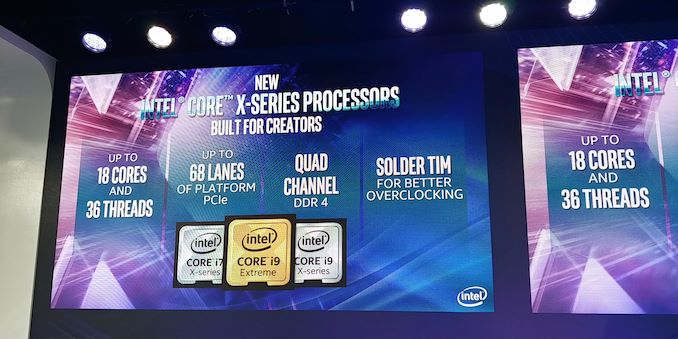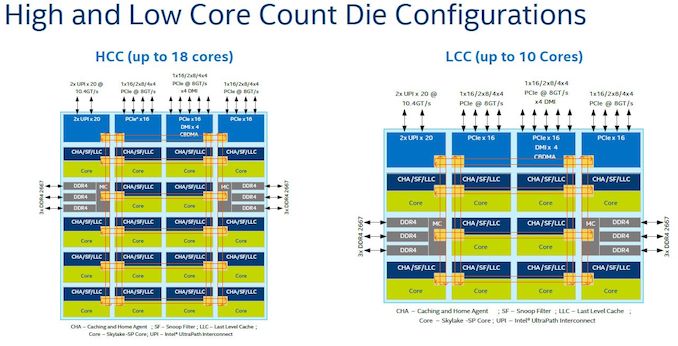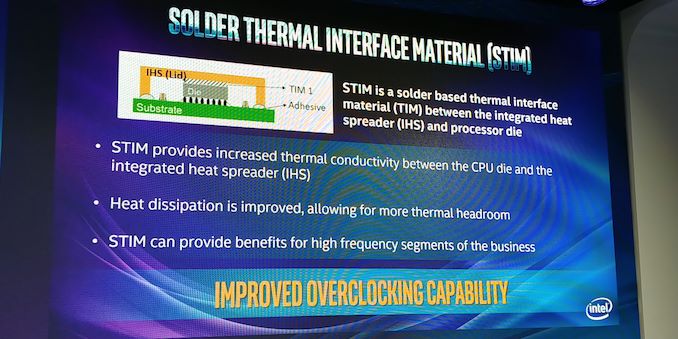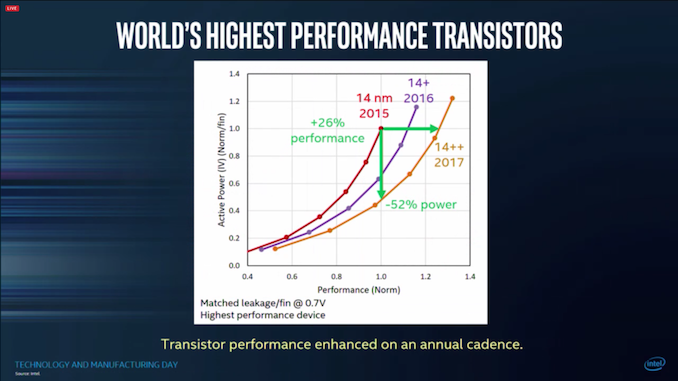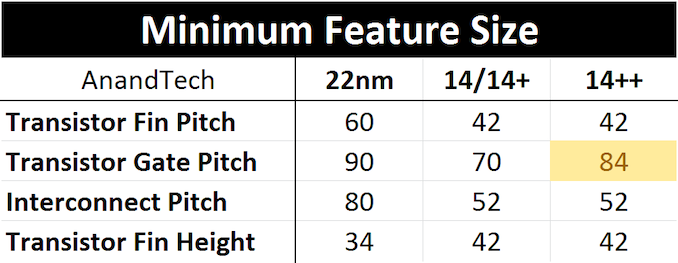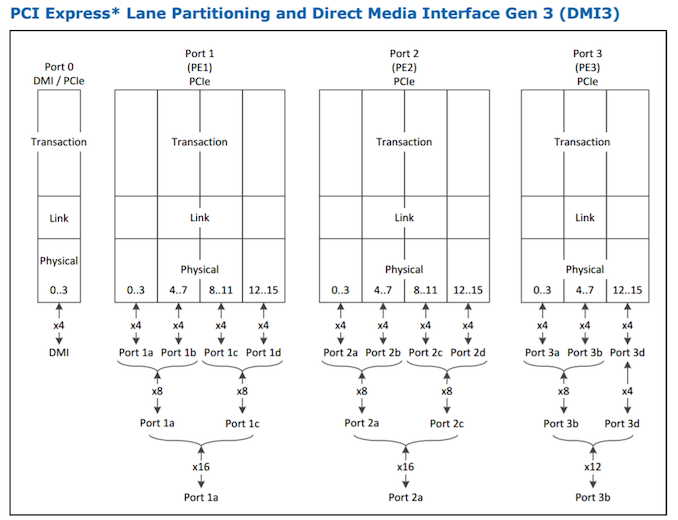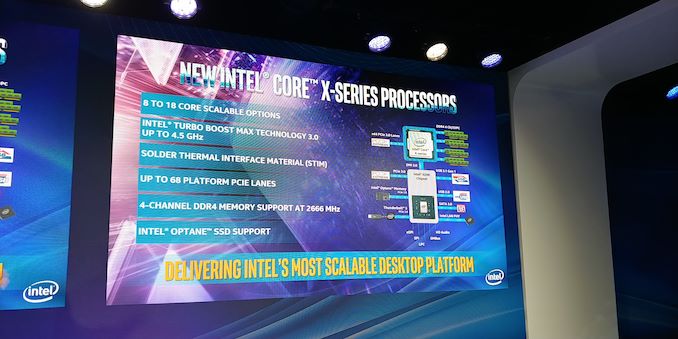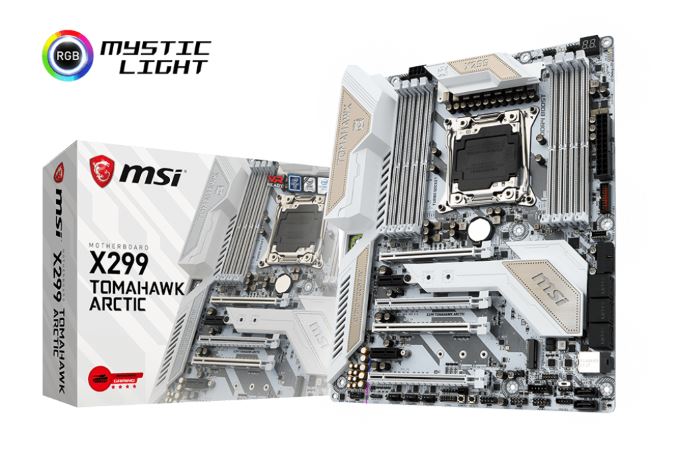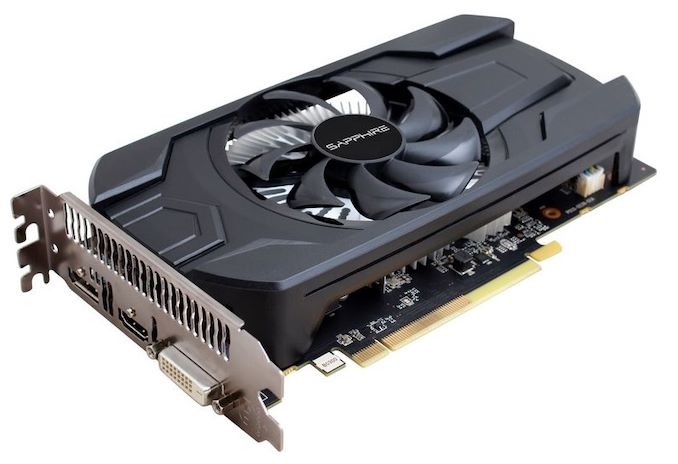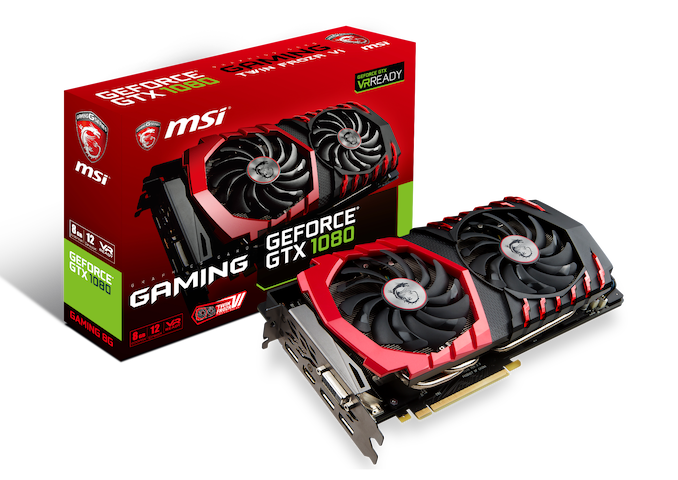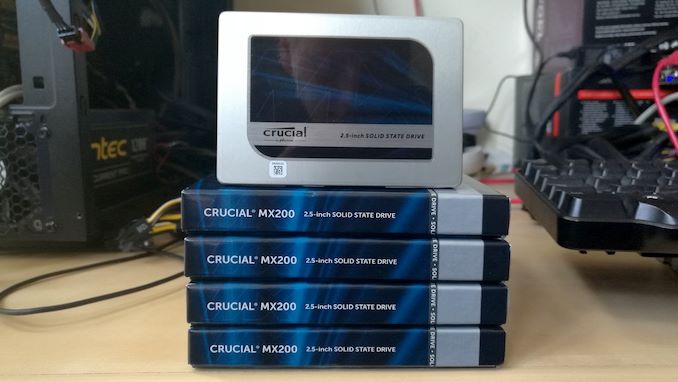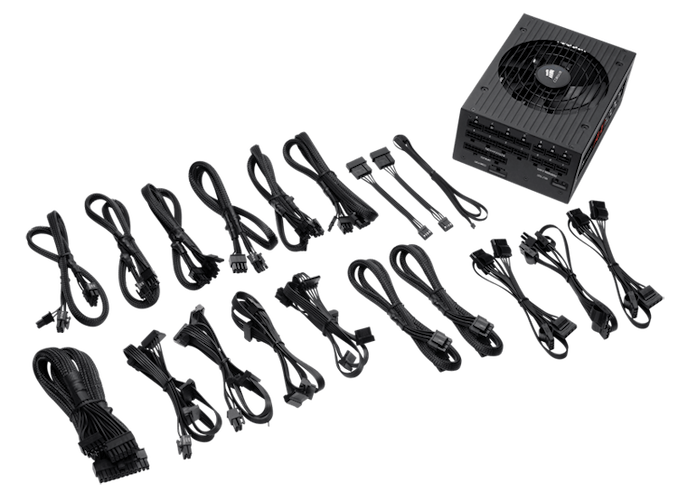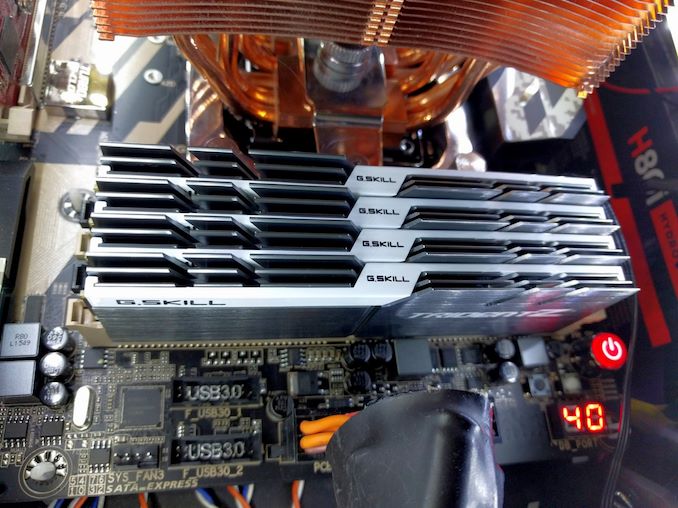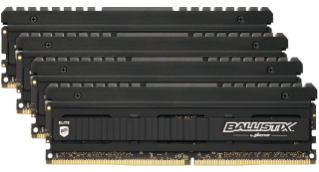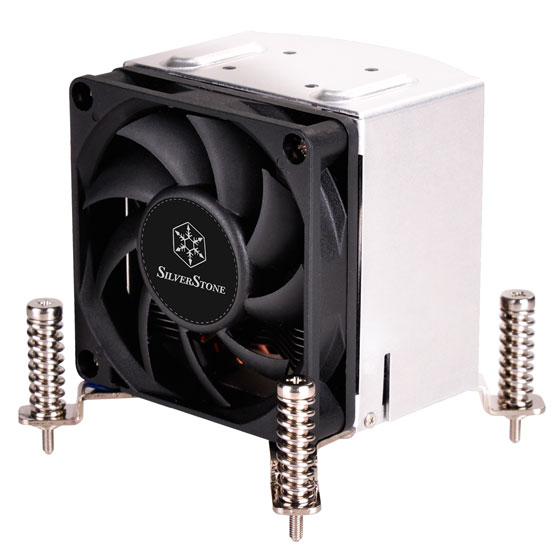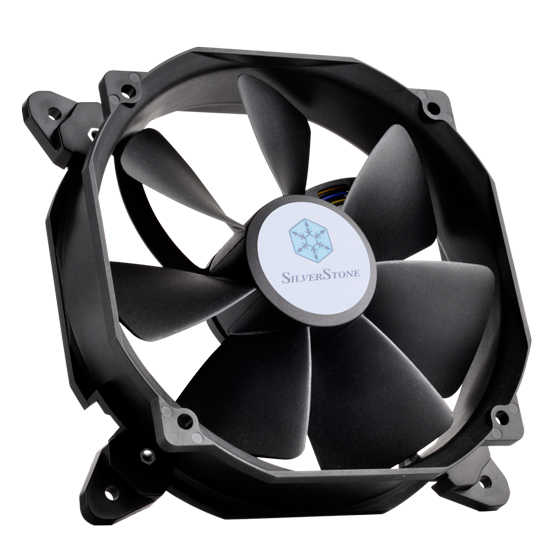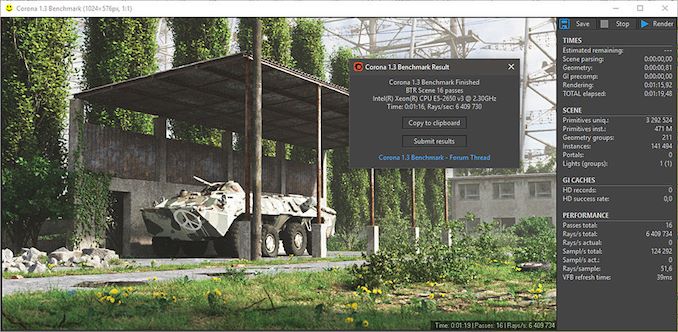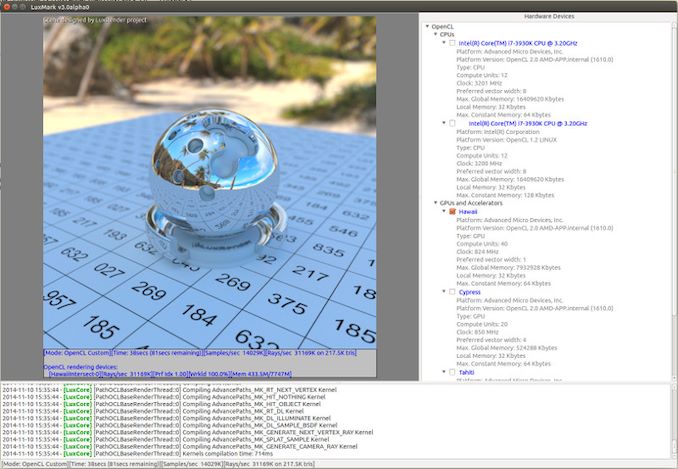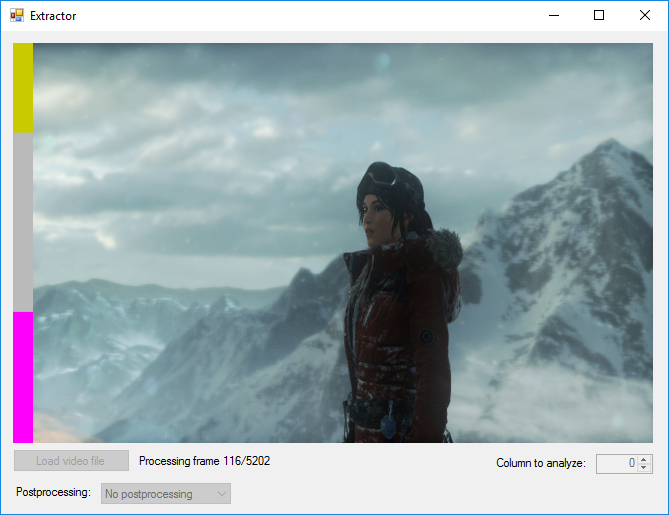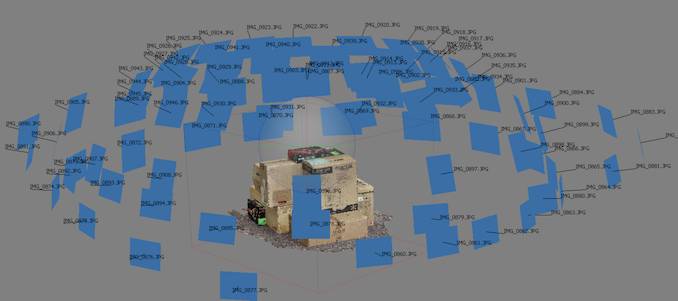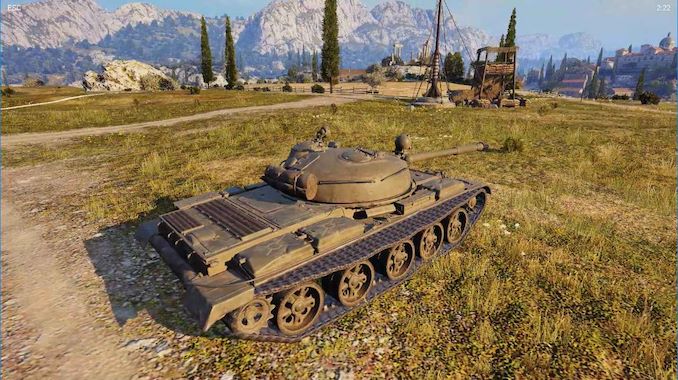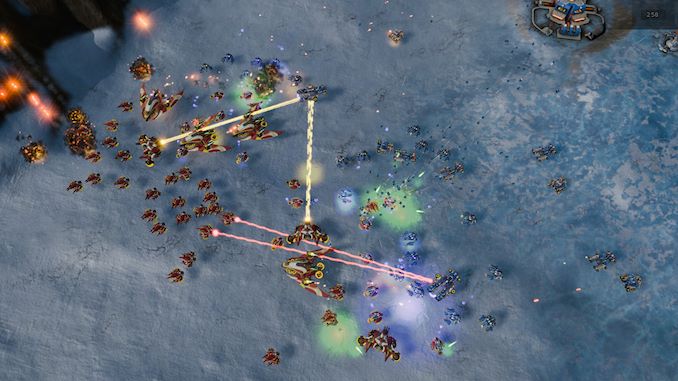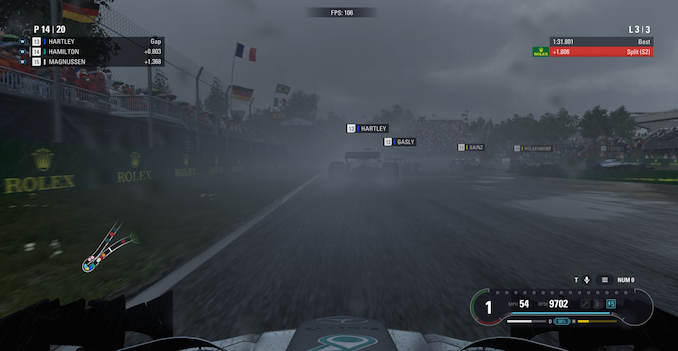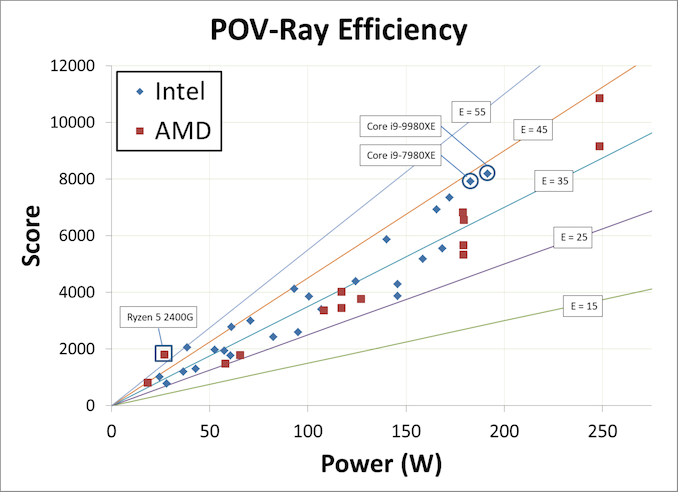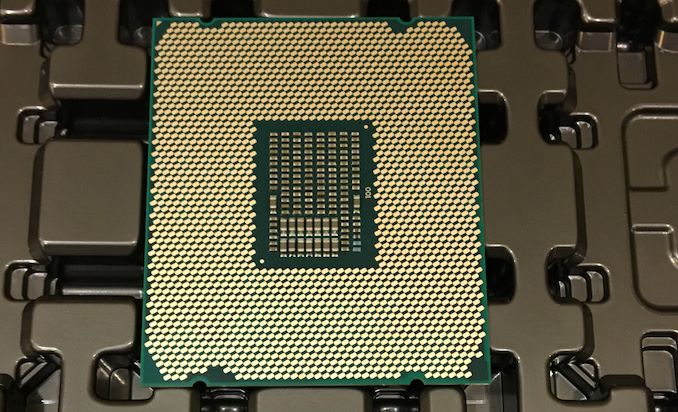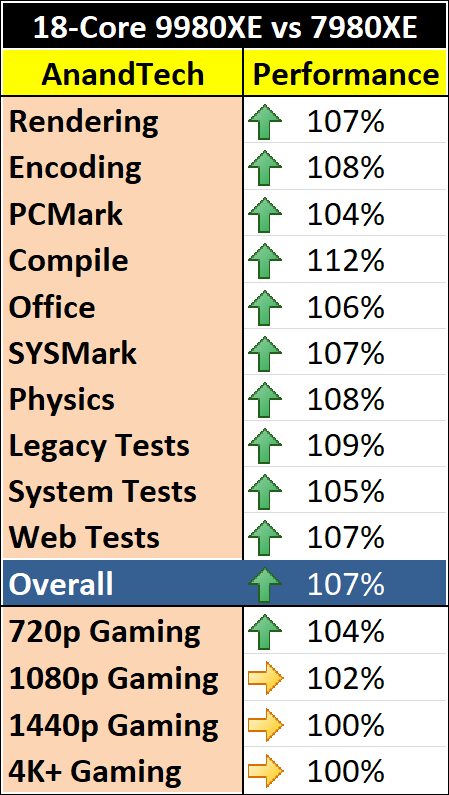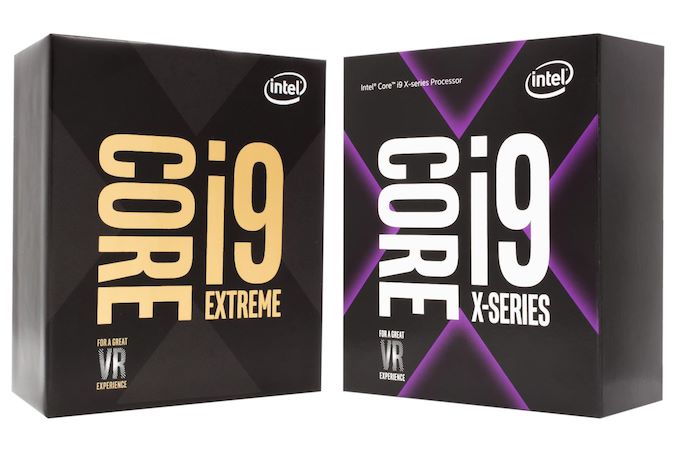
Original Link: https://www.anandtech.com/show/13539/the-intel-core-i9-9980xe-review
The Intel Core i9-9980XE CPU Review: Refresh Until it Hertz
by Ian Cutress on November 13, 2018 9:00 AM EST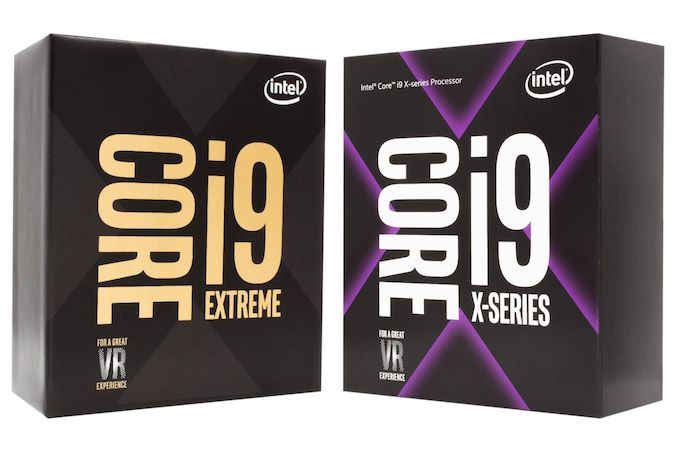
It has been over a year since Intel launched its Skylake-X processors and Basin Falls platform, with a handful of processors from six-core up to eighteen-core. In that time, Intel’s competition has gone through the roof in core count, PCIe lanes, power consumption. In order to compete, Intel has gone down a different route, with its refresh product stack focusing on frequency, cache updates, and an updated thermal interface. Today we are testing the top processor on that list, the Core i9-9980XE.
Intel’s Newest Processors
In October, at their Fall Desktop Event, Intel lifted the lid on its new generation of high-end desktop processors. There will be seven new processors in all, with the Core i9-9980XE eighteen-core part at the top, down to the eight-core Core i7-9800X as the cheapest model.
| Intel Basin Falls Skylake-X Refresh | ||||||||
| AnandTech | Cores | TDP | Freq | L3 (MB) |
L3 Per Core |
DRAM DDR4 |
PCIe | |
| i9-9980XE | $1979 | 18 / 36 | 165 W | 3.0 / 4.5 | 24.75 | 1.375 | 2666 | 44 |
| i9-9960X | $1684 | 16 / 32 | 165 W | 3.1 / 4.5 | 22.00 | 1.375 | 2666 | 44 |
| i9-9940X | $1387 | 14 / 28 | 165 W | 3.3 / 4.5 | 19.25 | 1.375 | 2666 | 44 |
| i9-9920X | $1189 | 12 / 24 | 165 W | 3.5 / 4.5 | 19.25 | 1.604 | 2666 | 44 |
| i9-9900X | $989 | 10 / 20 | 165 W | 3.5 / 4.5 | 19.25 | 1.925 | 2666 | 44 |
| i9-9820X | $889 | 10 / 20 | 165 W | 3.3 / 4.2 | 16.50 | 1.650 | 2666 | 44 |
| i7-9800X | $589 | 8 / 16 | 165 W | 3.8 / 4.5 | 16.50 | 2.031 | 2666 | 44 |
The key highlights on these new processors is the increased frequency of most of the parts compared to the models they replace, the increased L3 cache on most of the parts, and now all of Intel’s high-end desktop processors will have 44 PCIe lanes from the CPU out of the box (not including chipset lanes).
When doing a direct comparison to the previous generation of Intel’s high-end desktop processors, the key highlights are in the frequency. There is no six-core processor any more, given that the mainstream processor line goes up to eight cores. Anything with twelve cores or below gets extra L3 cache and 44 PCIe lanes, but also rises up to a sustained TDP of 165W.
All of the new processors will be manufactured on Intel’s 14++ node, which allows for the higher frequency, and will use a soldered thermal material between the processor and the heatspreader to help manage temperatures.
New HCC Wrapping
Intel’s high-end desktop cadence since 2010 has been relatively straightforward: firstly a new microarchitecture with a new socket on a new platform, followed by an update using the same microarchitecture and socket but on a new process node. The Skylake-X Refresh (or Basin Falls Refresh, named after the chipset family) series of processors breaks that mold.
The new processors instead take advantage of Intel’s middle-sized silicon configuration to exploit additional L3 cache. I’ll break this down in to what it actually means:
Intel historically creates three different sizes of enterprise CPUs: a low core count (LCC) design, a high core count (HCC) design, and an extreme core count design (XCC). For the Skylake-SP family, the latest enterprise family, the LCC design offers up to 10 cores and 13.75MB L3 cache, the HCC design is up to 18 cores and 24.75 MB L3 cache, and the XCC design is up to 28 cores with 38.5 MB of L3 cache. Intel then disables cores to fit the required configurations its customer needs. However, an 8 core processor in this model could be a 10-core LCC cut down by two cores, or an 18-core HCC cut down by 10 cores. Some of those cut cores can have their L3 cache still enabled, creating more differentiation.
For the high-end desktop, Intel usually uses the LCC core count design exclusively. For Skylake-X, this changed, and Intel started to offer HCC designs up to 18 cores in its desktop portfolio. The split was very obvious – anything 10 core or under was LCC, and 12-18 core was HCC. The options were very strict – the 14 core part had 14 cores of L3 cache, 12 core part had 12 cores of L3 cache, and so on. Intel also split the processors into some that had 28 PCIe lanes and some with 44 PCIe lanes.
For the new refresh parts, Intel has decided that there are no LCC variants any more. Every new processor is a HCC variant, cut down from the 18-core HCC die. If Intel didn’t tell us this outright, it would be easily spotted by the L3 cache counts: the lowest new chip is the Core i7-9800X, an eight-core processor with 16.5 MB of L3 cache, which would be more than the LCC silicon could offer.
Using HCC across all of the new processors is a double-edged sword. On the plus side, some CPUs have more cache, and everyone has 44 PCIe lanes. On the downside, the TDP has increased to 165W for some of those parts, but it also means that a lot of silicon is perhaps being ‘wasted’. The HCC silicon is significantly larger than the LCC silicon, and Intel gets fewer working processors per wafer it manufactures. This ultimately means that if these processors were in high demand, its ability to manufacture more could be lower. On the flip side, having one silicon design for the whole processor range, but with bits disabled, might make stock management easier.
Because the new parts are using Skylake-X cores, it comes with AVX512 support as well as Intel's mesh interconnect. As with the original Skylake-X parts, Intel is not defining the base frequency of the mesh, but suggesting a recommended range for the mesh frequency. This means that we are likely to see motherboard vendors very in their mesh frequency implementation: some will run at the peak turbo mesh frequency at all times, some will follow the mesh frequency with the core frequency, and others will run the mesh at the all-core turbo frequency.
Soldered Thermal Interface Material (sTIM)
One of the key messages out of Intel’s Fall Desktop Launch event is a return to higher performance thermal interface materials. As we’ve covered several times in the past, Intel has been reverting back to using a base thermal grease in its processor designs. This thermal grease typically has better longevity through thermal cycling (although we’re comparing years of use to years of use), is cheaper, but performs worse for thermal management. The consumer line from Intel has been using thermal grease since Ivy Bridge, while the high-end desktop processors were subjected to grease for Skylake-X.
| Thermal Interface | |||||||
| Intel | |||||||
| Intel | Celeron | Pentium | Core i3 | Core i5 | Core i7 Core i9 |
HEDT | |
| Sandy Bridge | LGA1155 | Paste | Paste | Paste | Bonded | Bonded | Bonded |
| Ivy Bridge | LGA1155 | Paste | Paste | Paste | Paste | Paste | Bonded |
| Haswell / DK | LGA1150 | Paste | Paste | Paste | Paste | Paste | Bonded |
| Broadwell | LGA1150 | Paste | Paste | Paste | Paste | Paste | Bonded |
| Skylake | LGA1151 | Paste | Paste | Paste | Paste | Paste | Paste |
| Kaby Lake | LGA1151 | Paste | Paste | Paste | Paste | Paste | - |
| Coffee Lake | 1151 v2 | Paste | Paste | Paste | Paste | Paste | - |
| CFL-R | 1151 v2 | ? | ? | ? | K = Bonded | - | |
| AMD | |||||||
| Zambezi | AM3+ | Bonded | Carrizo | AM4 | Bonded | ||
| Vishera | AM3+ | Bonded | Bristol R | AM4 | Bonded | ||
| Llano | FM1 | Paste | Summit R | AM4 | Bonded | ||
| Trinity | FM2 | Paste | Raven R | AM4 | Paste | ||
| Richland | FM2 | Paste | Pinnacle | AM4 | Bonded | ||
| Kaveri | FM2+ | Paste / Bonded* | TR | TR4 | Bonded | ||
| Carrizo | FM2+ | Paste | TR2 | TR4 | Bonded | ||
| Kabini | AM1 | Paste | |||||
| *Some Kaveri Refresh were bonded | |||||||
With the update to 9th Generation parts, both consumer overclockable processors and all of the high-end desktop processors, Intel is moving back to a soldered interface. The use of a liquid-metal bonding agent between the processor and the heatspreader should help improve thermal efficiency and the ability to extract thermal energy away from the processor quicker when sufficient coolers are applied. It should also remove the need for some extreme enthusiasts to ‘delid’ the processor to put their own liquid metal interface between the two.
The key thing here from the Intel event is that in the company’s own words, it recognizes that a soldered interface provides better thermal performance and ‘can provide benefits for high frequency segments of the business’. This is where enthusiasts rejoice. For professional or commercial users who are looking for stability, this upgrade will help the processors run cooler for a given thermal solution.
How Did Intel Gain 15% Efficiency?
Looking at the base frequency ratings, the Core i9-9980XE is set to run at 3.0 GHz for a sustained TDP of 165W. Comparing that to the previous generation which is only at 2.6 GHz, this would equate to a 15% increase in efficiency in real terms. These new processors have no microarchitectural changes over the previous generation, so the answers lie into two main areas: binning and process optimization.
The binning argument is easy – if Intel tightened the screws on its best bin, then we would see a really nice product. A company as large as Intel has to balance how often they get a processor to fall into a bin with demand – there’s no point advertising a magical 28-core 5 GHz CPU at a low TDP if only one in a million hits that value.
Process optimization is going to be a likely cause in that case. Intel is now manufacturing these parts on its 14++ manufacturing node, which is part of Intel’s ‘14nm class family’, and is a slightly relaxed version of 14+ with a larger transistor gate pitch to allow for a higher frequency:
As with all adjustments to semiconductor processes, if you improve one parameter then several others change as well. The increase in higher frequency typically means higher power consumption and energy output, which can be assisted with the thermal interface. To use 14++ over 14+, Intel might have also had to use new masks, which might allow for some minor adjustments to also improve power consumption/thermal efficiency. One of the key features right now in CPU world is the ability for the chip to track voltage per-core more efficiently do decrease overall power consumption, however Intel doesn’t usually spill the beans on features like this unless it has a point to prove.
Exactly how much performance Intel has gained with its new processor stack will come through in our testing.
More PCIe 3.0 Please: You Get 44 Lanes, Everyone Gets 44 Lanes
The high-end desktop space has started becoming a PCIe lane competition. The more lanes that are available direct from the processor, the more accelerators, high-performance networking, and high-performance storage options can be applied on the same motherboard. Rather than offering slightly cheaper, lower core count models with only 28 lanes (and making motherboard layout a complete pain), Intel has decided that each of its new CPUs will offer 44 PCIe 3.0 lanes. This makes motherboard layouts much easier to understand, and allows plenty of high-speed storage through the CPU even for the cheaper parts.
On top of this, Intel likes to promote that its high-end desktop chipset also has 24 PCIe 3.0 lanes available. This is a bit of a fudge, given that these lanes are bottlenecked by a PCIe 3.0 x4 link back to the CPU, and that some of these lanes will be taken up by USB ports or networking, but much like any connectivity hub, the idea is that the connections through the chipset are not ‘always hammered’ connections. What sticks in my craw though is that Intel likes to add up the 44 + 24 lanes to say that there are ’68 Platform PCIe 3.0 Lanes’, which implies they are all equal. That’s a hard no from me.
Intel faces competition here on PCIe lanes, as AMD’s high-end desktop Threadripper 2 platform offers 60 PCIe lanes on all of its parts. AMD also recently announced that its next generation 7nm enterprise processors will be using PCIe 4.0, so we can expect AMD’s HEDT platform to also get PCIe 4.0 at some point in the future. Intel will need to up its game here to remain competitive for sure.
Motherboard Options
The new high-end desktop processors are built to fit the LGA2066 socket and use X299 chipsets, and so any X299 motherboard on the market with a BIOS update should be able to accept these new parts, including the Core i9-9980XE. When we asked ASRock for a new BIOS, given that the ones listed did not state if the new processors were supported, we were told ‘actually the latest BIOS already does support them’. It sounds like the MB vendors have been ready with the microcode for a couple of months at least, so any user with an updated motherboard could be OK straight away (although we do suggest that you double check and update to the latest anyway).
For users looking at new high-end desktop systems, we have a wealth of motherboard reviews for you to look through:
- The MSI X299 XPower Gaming AC Review: Flagship Fantasy
- The ASRock X299 Extreme4 Motherboard Review: $200 Entry To HEDT
- The MSI X299 Gaming M7 ACK Motherboard Review: Light up the Night
- The ASUS Prime X299-Deluxe Motherboard Review: Onboard OLED and WiGig
- The EVGA X299 Micro Motherboard Review: A Smaller Take on X299
- The EVGA X299 FTW K Motherboard Review: Dual U.2 Ports
- The GIGABYTE X299 Gaming 7 Pro Motherboard, Reviewed
- The ASUS ROG Strix X299-XE Gaming Motherboard Review: Strix Refined
- The ASUS TUF X299 Mark I Motherboard Review: TUF Refined
- The MSI X299 SLI Plus Motherboard Review: $232 with U.2
- The MSI X299 Tomahawk Arctic Motherboard Review: White as Snow
- The ASRock X299 Taichi Motherboard Review
- The ASRock X299 Professional Gaming i9 Motherboard Review
- The MSI X299 Gaming Pro Carbon AC Motherboard Review
We are likely to see some new models come to market as part of the refresh, as we’ve already seen with GIGABYTE’s new X299-UA8 system with dual PLX chips, although most vendors have substantial X299 motherboard lines already.
The Competition
In this review of the Core i9-9980XE, Intel has two classes of competition.
Firstly, itself. The Core i9-7980XE was the previous generation flagship, and will undoubtedly be offered at discount when the i9-9980XE hits the shelves. There’s also the question of whether more cores or higher frequency is best, which will be answered on a per-benchmark basis. We have all the Skylake-X 7000-series HEDT processors tested for just such an answer. We will test the rest of the 9000-series when samples are made available.
| AnandTech | Cores | TDP | Freq | L3 (MB) |
L3 Per Core |
DRAM DDR4 |
PCIe | |
| Intel | ||||||||
| i9-9980XE | $1979 | 18 / 36 | 165 W | 3.0 / 4.5 | 24.75 | 1.375 | 2666 | 44 |
| i9-7980XE | $1999 | 18 / 36 | 165 W | 2.5 / 4,4 | 24.75 | 1.375 | 2666 | 44 |
| AMD | ||||||||
| TR 2990WX | $1799 | 32 / 64 | 250 W | 3.0 / 4.2 | 64.00 | 2.000 | 2933 | 60 |
| TR 2970WX | $1299 | 24 / 48 | 250 W | 3.0 / 4.2 | 64.00 | 2.000 | 2933 | 60 |
| TR 2950X | $899 | 16 / 32 | 180 W | 3.5 / 4.4 | 32.00 | 2.000 | 2933 | 60 |
Secondly, AMD. The recent release of the Threadripper 2 set of processors is likely to have been noticed by Intel, offering 32 cores at just under the price of Intel’s 18-core Core i9-9980XE. What we found in our review of the Threadripper 2990WX is that for benchmarks that can take advantage of the bi-modal configuration, Intel cannot compete. However, Intel’s processors cover a wider range of workloads more effectively. It’s a tough sell when we compare items such as the 12-core AMD vs 12-core Intel, where benchmarks come out equal but AMD is half the price with more PCIe lanes. This is going to be a tricky one for Intel to be competitive on all fronts (and vice versa).
Availability and Pricing
Interestingly, Intel only offered us our review sample of the i9-9980XE last week. I suspect that this means that the processors, or at least the i9-9980XE, should be available from today. If not, then very soon: Intel has promised by the end of the year, along with the 28-core Xeon W-3175X as well (still no word on that yet).
Pricing is as follows:
| Pricing | ||
| Intel* | AMD** | |
| i9-9980XE | $1979 | |
| $1799 | TR 2990WX | |
| i9-9960X | $1684 | |
| i9-9940X | $1387 | |
| $1299 | TR 2970WX | |
| i9-9920X | $1189 | |
| i9-9900X | $989 | |
| i9-9820X | ~$890 | TR 2950X |
| $649 | TR 2920X | |
| i7-9800X | $589 | |
| i9-9900K | $488 | |
| $329 | Ryzen 7 2700X | |
| * Intel pricing is per 1k units ** AMD pricing is suggested retail pricing |
||
Pages In This Review
- Analysis and Competition
- Test Bed and Setup
- 2018 and 2019 Benchmark Suite: Spectre and Meltdown Hardened
- HEDT Performance: Encoding Tests
- HEDT Performance: Rendering Tests
- HEDT Performance: System Tests
- HEDT Performance: Office Tests
- HEDT Performance: Web and Legacy Tests
- HEDT Performance: SYSMark 2018
- Gaming: World of Tanks enCore
- Gaming: Final Fantasy XV
- Gaming: Shadow of War
- Gaming: Civilization 6
- Gaming: Ashes Classic
- Gaming: Strange Brigade
- Gaming: Grand Theft Auto V
- Gaming: Far Cry 5
- Gaming: Shadow of the Tomb Raider
- Gaming: F1 2018
- Power Consumption
- Conclusions and Final Words
Test Bed and Setup
As per our processor testing policy, we take a premium category motherboard suitable for the socket, and equip the system with a suitable amount of memory running at the manufacturer's maximum supported frequency. This is also typically run at JEDEC subtimings where possible. It is noted that some users are not keen on this policy, stating that sometimes the maximum supported frequency is quite low, or faster memory is available at a similar price, or that the JEDEC speeds can be prohibitive for performance. While these comments make sense, ultimately very few users apply memory profiles (either XMP or other) as they require interaction with the BIOS, and most users will fall back on JEDEC supported speeds - this includes home users as well as industry who might want to shave off a cent or two from the cost or stay within the margins set by the manufacturer. Where possible, we will extend out testing to include faster memory modules either at the same time as the review or a later date.
| Test Setup | |||||
| Intel HEDT | i9-9980XE i9-7980XE i9-7960X i9-7940X i9-7920X |
ASRock X299 OC Formula |
P1.40 | TRUE Copper |
Crucial Ballistix 4x4GB DDR4-2666 |
| AMD TR4 | TR2 2970WX TR2 2920X |
ASUS ROG X399 Zenith |
1501 | Enermax Liqtech TR4 |
Corsair Vengeance RGB Pro 4x8GB DDR4-2933 |
| TR2 2990WX TR2 2950X |
ASUS ROG X399 Zenith |
0508 | Enermax Liqtech TR4 |
G.Skill FlareX 4x8GB DDR4-2933 |
|
| GPU | Sapphire RX 460 2GB (CPU Tests) MSI GTX 1080 Gaming 8G (Gaming Tests) |
||||
| PSU | Corsair AX860i Corsair AX1200i |
||||
| SSD | Crucial MX200 1TB | ||||
| OS | Windows 10 x64 RS3 1709 Spectre and Meltdown Patched |
||||
| VRM Supplimented with SST-FHP141-VF 173 CFM fans | |||||
Unfortunately due to travel back and forth to the US for AMD’s Horizon Event and Supercomputing 2018, I was unable to look into overclocking performance for this review. We will hopefully cover it in another article.
Many thanks to...
We must thank the following companies for kindly providing hardware for our multiple test beds. Some of this hardware is not in this test bed specifically, but is used in other testing.
Our New Testing Suite for 2018 and 2019
Spectre and Meltdown Hardened
In order to keep up to date with our testing, we have to update our software every so often to stay relevant. In our updates we typically implement the latest operating system, the latest patches, the latest software revisions, the newest graphics drivers, as well as add new tests or remove old ones. As regular readers will know, our CPU testing revolves an automated test suite, and depending on how the newest software works, the suite either needs to change, be updated, have tests removed, or be rewritten completely. Last time we did a full re-write, it took the best part of a month, including regression testing (testing older processors).
One of the key elements of our testing update for 2018 (and 2019) is the fact that our scripts and systems are designed to be hardened for Spectre and Meltdown. This means making sure that all of our BIOSes are updated with the latest microcode, and all the steps are in place with our operating system with updates. In this case we are using Windows 10 x64 Enterprise 1709 with April security updates which enforces Smeltdown (our combined name) mitigations. Uses might ask why we are not running Windows 10 x64 RS4, the latest major update – this is due to some new features which are giving uneven results. Rather than spend a few weeks learning to disable them, we’re going ahead with RS3 which has been widely used.
Our previous benchmark suite was split into several segments depending on how the test is usually perceived. Our new test suite follows similar lines, and we run the tests based on:
- Power
- Memory
- Office
- System
- Render
- Encoding
- Web
- Legacy
- Integrated Gaming
- CPU Gaming
Depending on the focus of the review, the order of these benchmarks might change, or some left out of the main review. All of our data will reside in our benchmark database, Bench, for which there is a new ‘CPU 2019’ section for all of our new tests.
Within each section, we will have the following tests:
Power
Our power tests consist of running a substantial workload for every thread in the system, and then probing the power registers on the chip to find out details such as core power, package power, DRAM power, IO power, and per-core power. This all depends on how much information is given by the manufacturer of the chip: sometimes a lot, sometimes not at all.
We are currently running POV-Ray as our main test for Power, as it seems to hit deep into the system and is very consistent. In order to limit the number of cores for power, we use an affinity mask driven from the command line.
Memory
These tests involve disabling all turbo modes in the system, forcing it to run at base frequency, and them implementing both a memory latency checker (Intel’s Memory Latency Checker works equally well for both platforms) and AIDA64 to probe cache bandwidth.
Office
- Chromium Compile: Windows VC++ Compile of Chrome 56 (same as 2017)
- PCMark10: Primary data will be the overview results – subtest results will be in Bench
- 3DMark Physics: We test every physics sub-test for Bench, and report the major ones (new)
- GeekBench4: By request (new)
- SYSmark 2018: Recently released by BAPCo, currently automating it into our suite (new, when feasible)
System
- Application Load: Time to load GIMP 2.10.4 (new)
- FCAT: Time to process a 90 second ROTR 1440p recording (same as 2017)
- 3D Particle Movement: Particle distribution test (same as 2017) – we also have AVX2 and AVX512 versions of this, which may be added later
- Dolphin 5.0: Console emulation test (same as 2017)
- DigiCortex: Sea Slug Brain simulation (same as 2017)
- y-Cruncher v0.7.6: Pi calculation with optimized instruction sets for new CPUs (new)
- Agisoft Photoscan 1.3.3: 2D image to 3D modelling tool (updated)
Render
- Corona 1.3: Performance renderer for 3dsMax, Cinema4D (same as 2017)
- Blender 2.79b: Render of bmw27 on CPU (updated to 2.79b)
- LuxMark v3.1 C++ and OpenCL: Test of different rendering code paths (same as 2017)
- POV-Ray 3.7.1: Built-in benchmark (updated)
- CineBench R15: Older Cinema4D test, will likely remain in Bench (same as 2017)
Encoding
- 7-zip 1805: Built-in benchmark (updated to v1805)
- WinRAR 5.60b3: Compression test of directory with video and web files (updated to 5.60b3)
- AES Encryption: In-memory AES performance. Slightly older test. (same as 2017)
- Handbrake 1.1.0: Logitech C920 1080p60 input file, transcoded into three formats for streaming/storage:
- 720p60, x264, 6000 kbps CBR, Fast, High Profile
- 1080p60, x264, 3500 kbps CBR, Faster, Main Profile
- 1080p60, HEVC, 3500 kbps VBR, Fast, 2-Pass Main Profile
Web
- WebXPRT3: The latest WebXPRT test (updated)
- WebXPRT15: Similar to 3, but slightly older. (same as 2017)
- Speedometer2: Javascript Framework test (new)
- Google Octane 2.0: Depreciated but popular web test (same as 2017)
- Mozilla Kraken 1.1: Depreciated but popular web test (same as 2017)
Legacy (same as 2017)
- 3DPM v1: Older version of 3DPM, very naïve code
- x264 HD 3.0: Older transcode benchmark
- Cinebench R11.5 and R10: Representative of different coding methodologies
Linux (when feasible)
When in full swing, we wish to return to running LinuxBench 1.0. This was in our 2016 test, but was ditched in 2017 as it added an extra complication layer to our automation. By popular request, we are going to run it again.
Integrated and CPU Gaming
We have recently automated around a dozen games at four different performance levels. A good number of games will have frame time data, however due to automation complications, some will not. The idea is that we get a good overview of a number of different genres and engines for testing. So far we have the following games automated:
| AnandTech CPU Gaming 2019 Game List | ||||||||
| Game | Genre | Release Date | API | IGP | Low | Med | High | |
| World of Tanks enCore | Driving / Action | Feb 2018 |
DX11 | 768p Minimum |
1080p Medium |
1080p Ultra |
4K Ultra |
|
| Final Fantasy XV | JRPG | Mar 2018 |
DX11 | 720p Standard |
1080p Standard |
4K Standard |
8K Standard |
|
| Shadow of War | Action / RPG | Sep 2017 |
DX11 | 720p Ultra |
1080p Ultra |
4K High |
8K High |
|
| F1 2018 | Racing | Aug 2018 |
DX11 | 720p Low |
1080p Med |
4K High |
4K Ultra |
|
| Civilization VI | RTS | Oct 2016 |
DX12 | 1080p Ultra |
4K Ultra |
8K Ultra |
16K Low |
|
| Car Mechanic Simulator '18 | Simulation / Racing | July 2017 |
DX11 | 720p Low |
1080p Medium |
1440p High |
4K Ultra |
|
| Ashes: Classic | RTS | Mar 2016 |
DX12 | 720p Standard |
1080p Standard |
1440p Standard |
4K Standard |
|
| Strange Brigade* | FPS | Aug 2018 |
DX12 Vulkan |
720p Low |
1080p Medium |
1440p High |
4K Ultra |
|
| Shadow of the Tomb Raider | Action | Sep 2018 |
DX12 | 720p Low |
1080p Medium |
1440p High |
4K Highest |
|
| Grand Theft Auto V | Open World | Apr 2015 |
DX11 | 720p Low |
1080p High |
1440p Very High |
4K Ultra |
|
| Far Cry 5 | FPS | Mar 2018 |
DX11 | 720p Low |
1080p Normal |
1440p High |
4K Ultra |
|
| *Strange Brigade is run in DX12 and Vulkan modes | ||||||||
For our CPU Gaming tests, we will be running on an NVIDIA GTX 1080. For the CPU benchmarks, we use an RX460 as we now have several units for concurrent testing.
In previous years we tested multiple GPUs on a small number of games – this time around, due to a Twitter poll I did which turned out exactly 50:50, we are doing it the other way around: more games, fewer GPUs.
Scale Up vs Scale Out: Benefits of Automation
One comment we get every now and again is that automation isn’t the best way of testing – there’s a higher barrier to entry, and it limits the tests that can be done. From our perspective, despite taking a little while to program properly (and get it right), automation means we can do several things:
- Guarantee consistent breaks between tests for cooldown to occur, rather than variable cooldown times based on ‘if I’m looking at the screen’
- It allows us to simultaneously test several systems at once. I currently run five systems in my office (limited by the number of 4K monitors, and space) which means we can process more hardware at the same time
- We can leave tests to run overnight, very useful for a deadline
- With a good enough script, tests can be added very easily
Our benchmark suite collates all the results and spits out data as the tests are running to a central storage platform, which I can probe mid-run to update data as it comes through. This also acts as a mental check in case any of the data might be abnormal.
We do have one major limitation, and that rests on the side of our gaming tests. We are running multiple tests through one Steam account, some of which (like GTA) are online only. As Steam only lets one system play on an account at once, our gaming script probes Steam’s own APIs to determine if we are ‘online’ or not, and to run offline tests until the account is free to be logged in on that system. Depending on the number of games we test that absolutely require online mode, it can be a bit of a bottleneck.
Benchmark Suite Updates
As always, we do take requests. It helps us understand the workloads that everyone is running and plan accordingly.
A side note on software packages: we have had requests for tests on software such as ANSYS, or other professional grade software. The downside of testing this software is licensing and scale. Most of these companies do not particularly care about us running tests, and state it’s not part of their goals. Others, like Agisoft, are more than willing to help. If you are involved in these software packages, the best way to see us benchmark them is to reach out. We have special versions of software for some of our tests, and if we can get something that works, and relevant to the audience, then we shouldn’t have too much difficulty adding it to the suite.
HEDT Performance: Encoding Tests
With the rise of streaming, vlogs, and video content as a whole, encoding and transcoding tests are becoming ever more important. Not only are more home users and gamers needing to convert video files into something more manageable, for streaming or archival purposes, but the servers that manage the output also manage around data and log files with compression and decompression. Our encoding tasks are focused around these important scenarios, with input from the community for the best implementation of real-world testing.
All of our benchmark results can also be found in our benchmark engine, Bench.
Handbrake 1.1.0: Streaming and Archival Video Transcoding
A popular open source tool, Handbrake is the anything-to-anything video conversion software that a number of people use as a reference point. The danger is always on version numbers and optimization, for example the latest versions of the software can take advantage of AVX-512 and OpenCL to accelerate certain types of transcoding and algorithms. The version we use here is a pure CPU play, with common transcoding variations.
We have split Handbrake up into several tests, using a Logitech C920 1080p60 native webcam recording (essentially a streamer recording), and convert them into two types of streaming formats and one for archival. The output settings used are:
- 720p60 at 6000 kbps constant bit rate, fast setting, high profile
- 1080p60 at 3500 kbps constant bit rate, faster setting, main profile
- 1080p60 HEVC at 3500 kbps variable bit rate, fast setting, main profile
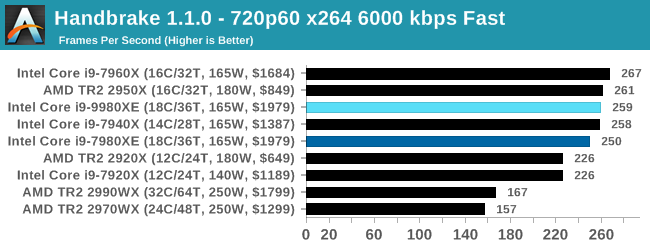
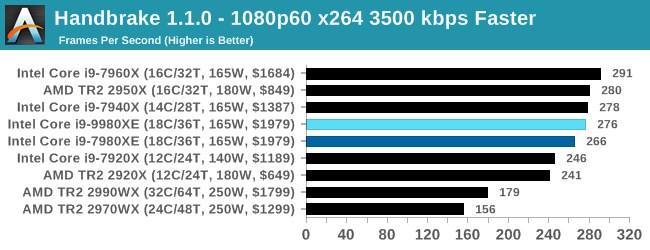
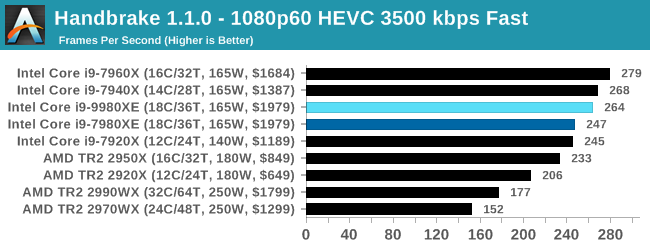
The 9980XE performs better than the 7980XE in our testing by a few percentage points, however these tests seem to benefit from fewer cores and a better turbo frequency profile.
7-zip v1805: Popular Open-Source Encoding Engine
Out of our compression/decompression tool tests, 7-zip is the most requested and comes with a built-in benchmark. For our test suite, we’ve pulled the latest version of the software and we run the benchmark from the command line, reporting the compression, decompression, and a combined score.
It is noted in this benchmark that the latest multi-die processors have very bi-modal performance between compression and decompression, performing well in one and badly in the other. There are also discussions around how the Windows Scheduler is implementing every thread. As we get more results, it will be interesting to see how this plays out.
Please note, if you plan to share out the Compression graph, please include the Decompression one. Otherwise you’re only presenting half a picture.
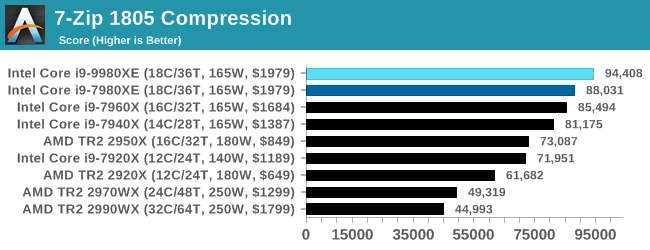
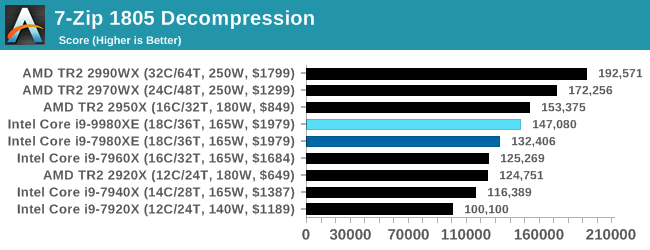
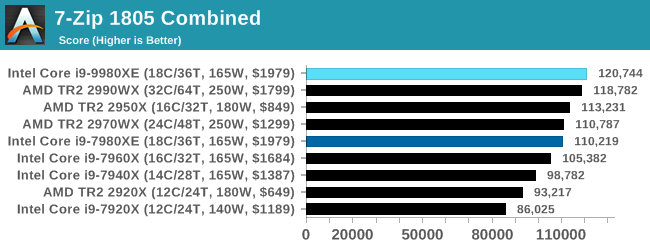
The increase in performance in both compression and decompression over the 7980XE pushes the 9980XE to the top of the overall standings.
WinRAR 5.60b3: Archiving Tool
My compression tool of choice is often WinRAR, having been one of the first tools a number of my generation used over two decades ago. The interface has not changed much, although the integration with Windows right click commands is always a plus. It has no in-built test, so we run a compression over a set directory containing over thirty 60-second video files and 2000 small web-based files at a normal compression rate.
WinRAR is variable threaded but also susceptible to caching, so in our test we run it 10 times and take the average of the last five, leaving the test purely for raw CPU compute performance.
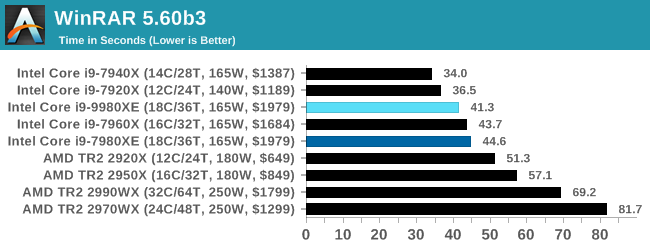
With WinRAR being a variable threaded and memory sensitive tool, while the 9980XE performs better than the 7980XE, having fewer Intel cores seems to work best.
AES Encryption: File Security
A number of platforms, particularly mobile devices, are now offering encryption by default with file systems in order to protect the contents. Windows based devices have these options as well, often applied by BitLocker or third-party software. In our AES encryption test, we used the discontinued TrueCrypt for its built-in benchmark, which tests several encryption algorithms directly in memory.
The data we take for this test is the combined AES encrypt/decrypt performance, measured in gigabytes per second. The software does use AES commands for processors that offer hardware selection, however not AVX-512.
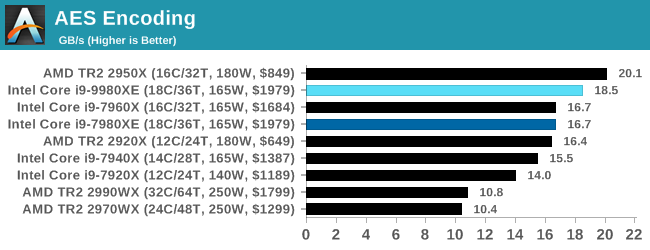
AES encoding seems to prefer AMD's situation, although the way the >16 core TR2 parts are configured is more of a hindrance. As expected, the i9-9980XE is the best Intel performer here.
HEDT Performance: Rendering Tests
Rendering is often a key target for processor workloads, lending itself to a professional environment. It comes in different formats as well, from 3D rendering through rasterization, such as games, or by ray tracing, and invokes the ability of the software to manage meshes, textures, collisions, aliasing, physics (in animations), and discarding unnecessary work. Most renderers offer CPU code paths, while a few use GPUs and select environments use FPGAs or dedicated ASICs. For big studios however, CPUs are still the hardware of choice.
All of our benchmark results can also be found in our benchmark engine, Bench.
Corona 1.3: Performance Render
An advanced performance based renderer for software such as 3ds Max and Cinema 4D, the Corona benchmark renders a generated scene as a standard under its 1.3 software version. Normally the GUI implementation of the benchmark shows the scene being built, and allows the user to upload the result as a ‘time to complete’.
We got in contact with the developer who gave us a command line version of the benchmark that does a direct output of results. Rather than reporting time, we report the average number of rays per second across six runs, as the performance scaling of a result per unit time is typically visually easier to understand.
The Corona benchmark website can be found at https://corona-renderer.com/benchmark
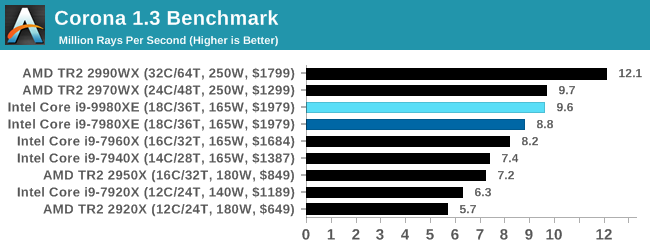
Corona sees improvement in line with the frequency gain, however the higher core count AMD parts win out here.
Blender 2.79b: 3D Creation Suite
A high profile rendering tool, Blender is open-source allowing for massive amounts of configurability, and is used by a number of high-profile animation studios worldwide. The organization recently released a Blender benchmark package, a couple of weeks after we had narrowed our Blender test for our new suite, however their test can take over an hour. For our results, we run one of the sub-tests in that suite through the command line - a standard ‘bmw27’ scene in CPU only mode, and measure the time to complete the render.
Blender can be downloaded at https://www.blender.org/download/
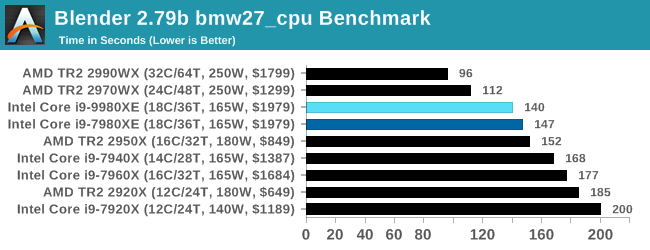
Similarly with Blender as to Corona: the new Intel Core i9-9980XE performs better than the previous generation 7980XE, but sits behind the higher core count AMD parts.
LuxMark v3.1: LuxRender via Different Code Paths
As stated at the top, there are many different ways to process rendering data: CPU, GPU, Accelerator, and others. On top of that, there are many frameworks and APIs in which to program, depending on how the software will be used. LuxMark, a benchmark developed using the LuxRender engine, offers several different scenes and APIs. *It has been mentioned that LuxMark, since the Spectre/Meltdown patches, is not a great representation of the LuxRender engine. We still use the test as a good example of different code path projections.
In our test, we run the simple ‘Ball’ scene on both the C++ and OpenCL code paths, but in CPU mode. This scene starts with a rough render and slowly improves the quality over two minutes, giving a final result in what is essentially an average ‘kilorays per second’.
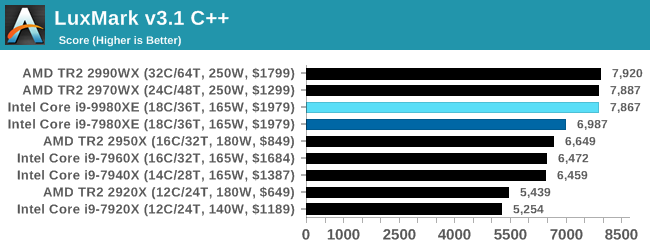
Our test here seems to put processors into buckets of performance. In this case, the Core i9-9980XE goes up a bucket.
POV-Ray 3.7.1: Ray Tracing
The Persistence of Vision ray tracing engine is another well-known benchmarking tool, which was in a state of relative hibernation until AMD released its Zen processors, to which suddenly both Intel and AMD were submitting code to the main branch of the open source project. For our test, we use the built-in benchmark for all-cores, called from the command line.
POV-Ray can be downloaded from http://www.povray.org/
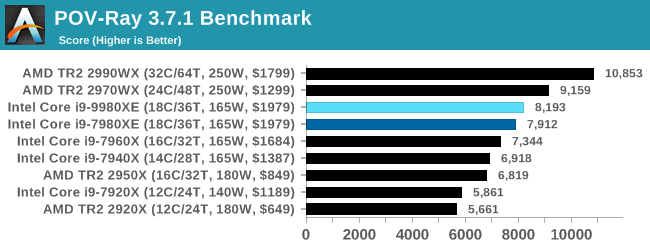
POV-Ray is as expected: a performance improvement, but behind the higher core count AMD parts.
HEDT Performance: System Tests
Our System Test section focuses significantly on real-world testing, user experience, with a slight nod to throughput. In this section we cover application loading time, image processing, simple scientific physics, emulation, neural simulation, optimized compute, and 3D model development, with a combination of readily available and custom software. For some of these tests, the bigger suites such as PCMark do cover them (we publish those values in our office section), although multiple perspectives is always beneficial. In all our tests we will explain in-depth what is being tested, and how we are testing.
All of our benchmark results can also be found in our benchmark engine, Bench.
Application Load: GIMP 2.10.4
One of the most important aspects about user experience and workflow is how fast does a system respond. A good test of this is to see how long it takes for an application to load. Most applications these days, when on an SSD, load fairly instantly, however some office tools require asset pre-loading before being available. Most operating systems employ caching as well, so when certain software is loaded repeatedly (web browser, office tools), then can be initialized much quicker.
In our last suite, we tested how long it took to load a large PDF in Adobe Acrobat. Unfortunately this test was a nightmare to program for, and didn’t transfer over to Win10 RS3 easily. In the meantime we discovered an application that can automate this test, and we put it up against GIMP, a popular free open-source online photo editing tool, and the major alternative to Adobe Photoshop. We set it to load a large 50MB design template, and perform the load 10 times with 10 seconds in-between each. Due to caching, the first 3-5 results are often slower than the rest, and time to cache can be inconsistent, we take the average of the last five results to show CPU processing on cached loading.
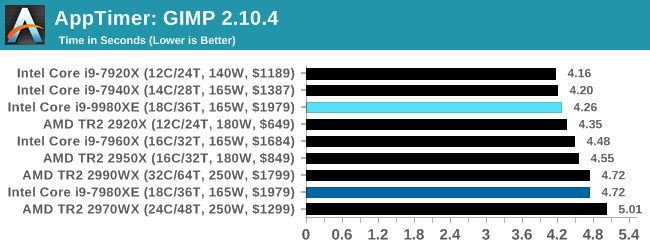
Loading software is usually an achilles heel of multi-core processors based on the lower frequency. The 9980XE pushes above and beyond the 7980XE in this regard, given it has better turbo performance across the board.
FCAT: Image Processing
The FCAT software was developed to help detect microstuttering, dropped frames, and run frames in graphics benchmarks when two accelerators were paired together to render a scene. Due to game engines and graphics drivers, not all GPU combinations performed ideally, which led to this software fixing colors to each rendered frame and dynamic raw recording of the data using a video capture device.
The FCAT software takes that recorded video, which in our case is 90 seconds of a 1440p run of Rise of the Tomb Raider, and processes that color data into frame time data so the system can plot an ‘observed’ frame rate, and correlate that to the power consumption of the accelerators. This test, by virtue of how quickly it was put together, is single threaded. We run the process and report the time to completion.
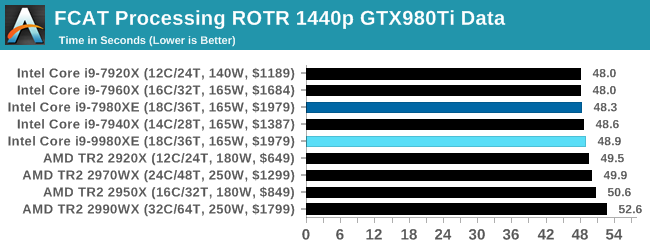
Despite the 9980XE having a higher frequency than the 7980XE, they both fall in the same region as all these HEDT processors seems to be trending towards 48 seconds. For context, the 5.0 GHz Core i9-9900K scores 44.7 seconds, another 8% or so faster.
3D Particle Movement v2.1: Brownian Motion
Our 3DPM test is a custom built benchmark designed to simulate six different particle movement algorithms of points in a 3D space. The algorithms were developed as part of my PhD., and while ultimately perform best on a GPU, provide a good idea on how instruction streams are interpreted by different microarchitectures.
A key part of the algorithms is the random number generation – we use relatively fast generation which ends up implementing dependency chains in the code. The upgrade over the naïve first version of this code solved for false sharing in the caches, a major bottleneck. We are also looking at AVX2 and AVX512 versions of this benchmark for future reviews.
For this test, we run a stock particle set over the six algorithms for 20 seconds apiece, with 10 second pauses, and report the total rate of particle movement, in millions of operations (movements) per second. We have a non-AVX version and an AVX version, with the latter implementing AVX512 and AVX2 where possible.
3DPM v2.1 can be downloaded from our server: 3DPMv2.1.rar (13.0 MB)
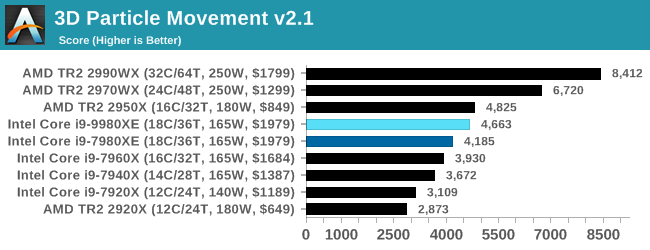
Without any AVX code, our 3DPM test shows that with fewer cores, AMD's 16-core Threadripper actually beats both of the 7980XE and 9980XE. The higher core count AMD parts blitz the field.
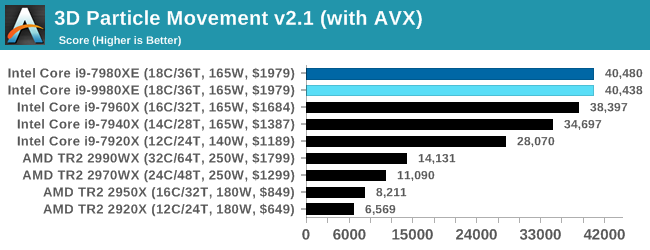
When we add AVX2 / AVX512, the Intel HEDT systems go above and beyond. This is the benefit of hand-tuned AVX512 code. Interestingly the 9980XE scores about the same as the 7980XE - I have a feeling that the AVX512 turbo tables for both chips are identical.
Dolphin 5.0: Console Emulation
One of the popular requested tests in our suite is to do with console emulation. Being able to pick up a game from an older system and run it as expected depends on the overhead of the emulator: it takes a significantly more powerful x86 system to be able to accurately emulate an older non-x86 console, especially if code for that console was made to abuse certain physical bugs in the hardware.
For our test, we use the popular Dolphin emulation software, and run a compute project through it to determine how close to a standard console system our processors can emulate. In this test, a Nintendo Wii would take around 1050 seconds.
The latest version of Dolphin can be downloaded from https://dolphin-emu.org/
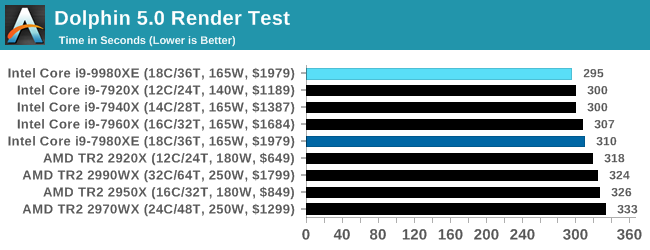
Dolphin enjoys single thread frequency, so at 4.5 GHz we see the 9980XE getting a small bump over the 7980XE.
DigiCortex 1.20: Sea Slug Brain Simulation
This benchmark was originally designed for simulation and visualization of neuron and synapse activity, as is commonly found in the brain. The software comes with a variety of benchmark modes, and we take the small benchmark which runs a 32k neuron / 1.8B synapse simulation, equivalent to a Sea Slug.
Example of a 2.1B neuron simulation
We report the results as the ability to simulate the data as a fraction of real-time, so anything above a ‘one’ is suitable for real-time work. Out of the two modes, a ‘non-firing’ mode which is DRAM heavy and a ‘firing’ mode which has CPU work, we choose the latter. Despite this, the benchmark is still affected by DRAM speed a fair amount.
DigiCortex can be downloaded from http://www.digicortex.net/
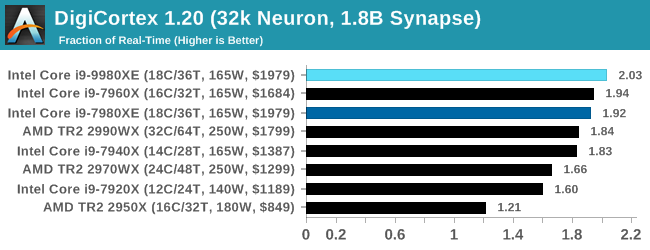
DigiCortex requires a good memory subsystem as well as cores and frequency. We get a small bump for the new 9980XE here.
y-Cruncher v0.7.6: Microarchitecture Optimized Compute
I’ve known about y-Cruncher for a while, as a tool to help compute various mathematical constants, but it wasn’t until I began talking with its developer, Alex Yee, a researcher from NWU and now software optimization developer, that I realized that he has optimized the software like crazy to get the best performance. Naturally, any simulation that can take 20+ days can benefit from a 1% performance increase! Alex started y-cruncher as a high-school project, but it is now at a state where Alex is keeping it up to date to take advantage of the latest instruction sets before they are even made available in hardware.
For our test we run y-cruncher v0.7.6 through all the different optimized variants of the binary, single threaded and multi-threaded, including the AVX-512 optimized binaries. The test is to calculate 250m digits of Pi, and we use the single threaded and multi-threaded versions of this test.
Users can download y-cruncher from Alex’s website: http://www.numberworld.org/y-cruncher/
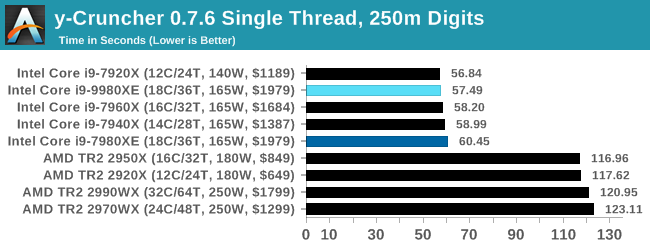
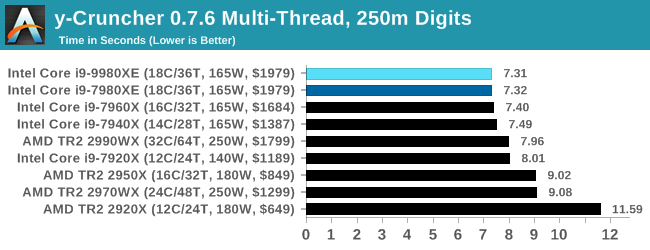
With another one of our AVX2/AVX512 tests, the Skylake-X parts win in both single thread and multi-threads.
Agisoft Photoscan 1.3.3: 2D Image to 3D Model Conversion
One of the ISVs that we have worked with for a number of years is Agisoft, who develop software called PhotoScan that transforms a number of 2D images into a 3D model. This is an important tool in model development and archiving, and relies on a number of single threaded and multi-threaded algorithms to go from one side of the computation to the other.
In our test, we take v1.3.3 of the software with a good sized data set of 84 x 18 megapixel photos and push it through a reasonably fast variant of the algorithms, but is still more stringent than our 2017 test. We report the total time to complete the process.
Agisoft’s Photoscan website can be found here: http://www.agisoft.com/
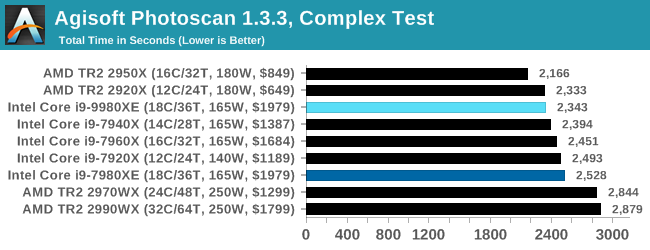
Photoscan is a mix of parallel compute and single threaded work, and the 9980XE does give another 7-8% performance over the 7980XE. The AMD dual-die TR2 parts still have the edge, however.
HEDT Performance: Office Tests
The Office test suite is designed to focus around more industry standard tests that focus on office workflows, system meetings, some synthetics, but we also bundle compiler performance in with this section. For users that have to evaluate hardware in general, these are usually the benchmarks that most consider.
All of our benchmark results can also be found in our benchmark engine, Bench.
PCMark 10: Industry Standard System Profiler
Futuremark, now known as UL, has developed benchmarks that have become industry standards for around two decades. The latest complete system test suite is PCMark 10, upgrading over PCMark 8 with updated tests and more OpenCL invested into use cases such as video streaming.
PCMark splits its scores into about 14 different areas, including application startup, web, spreadsheets, photo editing, rendering, video conferencing, and physics. We post all of these numbers in our benchmark database, Bench, however the key metric for the review is the overall score.
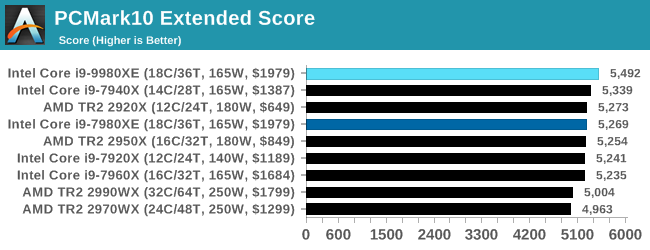
A small bump in the result here because of the added core frequency.
Chromium Compile: Windows VC++ Compile of Chrome 56
A large number of AnandTech readers are software engineers, looking at how the hardware they use performs. While compiling a Linux kernel is ‘standard’ for the reviewers who often compile, our test is a little more varied – we are using the windows instructions to compile Chrome, specifically a Chrome 56 build from March 2017, as that was when we built the test. Google quite handily gives instructions on how to compile with Windows, along with a 400k file download for the repo.
In our test, using Google’s instructions, we use the MSVC compiler and ninja developer tools to manage the compile. As you may expect, the benchmark is variably threaded, with a mix of DRAM requirements that benefit from faster caches. Data procured in our test is the time taken for the compile, which we convert into compiles per day.
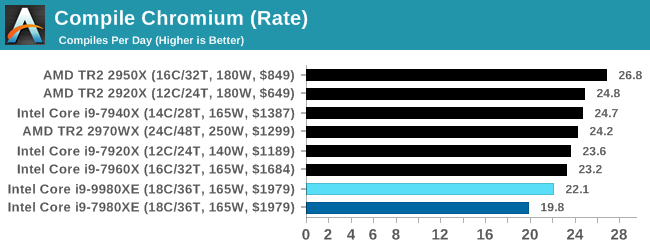
For the compile test, the 9980XE brings the 18-core up to being more competitive, however this test does seem to prefer fewer cores, lower crosstalk, and higher frequencies. AMD's 16-core TR2 wins here, adding 20% perf over the 9980XE for under half the cost.
3DMark Physics: In-Game Physics Compute
Alongside PCMark is 3DMark, Futuremark’s (UL’s) gaming test suite. Each gaming tests consists of one or two GPU heavy scenes, along with a physics test that is indicative of when the test was written and the platform it is aimed at. The main overriding tests, in order of complexity, are Ice Storm, Cloud Gate, Sky Diver, Fire Strike, and Time Spy.
Some of the subtests offer variants, such as Ice Storm Unlimited, which is aimed at mobile platforms with an off-screen rendering, or Fire Strike Ultra which is aimed at high-end 4K systems with lots of the added features turned on. Time Spy also currently has an AVX-512 mode (which we may be using in the future).
For our tests, we report in Bench the results from every physics test, but for the sake of the review we keep it to the most demanding of each scene: Cloud Gate, Sky Diver, Fire Strike Ultra, and Time Spy.
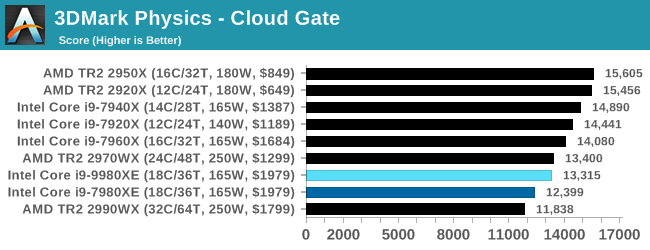
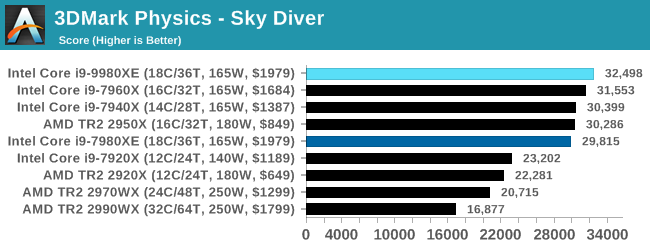
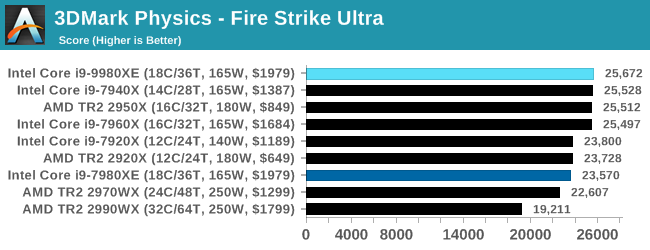
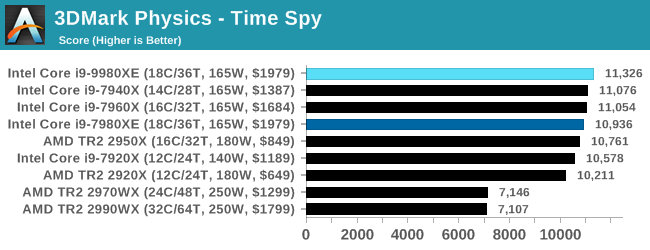
The newer engines can take advantage of the higher core count parts, and Intel's unified memory design also helps here.
GeekBench4: Synthetics
A common tool for cross-platform testing between mobile, PC, and Mac, GeekBench 4 is an ultimate exercise in synthetic testing across a range of algorithms looking for peak throughput. Tests include encryption, compression, fast Fourier transform, memory operations, n-body physics, matrix operations, histogram manipulation, and HTML parsing.
I’m including this test due to popular demand, although the results do come across as overly synthetic, and a lot of users often put a lot of weight behind the test due to the fact that it is compiled across different platforms (although with different compilers).
We record the main subtest scores (Crypto, Integer, Floating Point, Memory) in our benchmark database, but for the review we post the overall single and multi-threaded results.
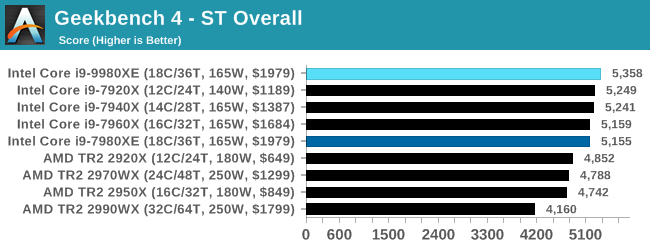
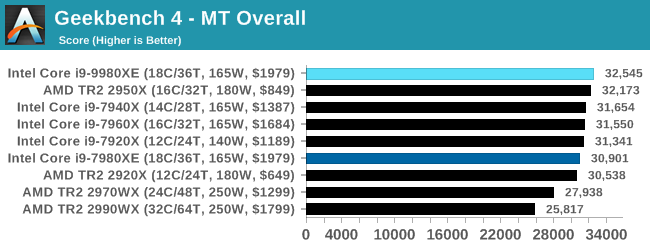
HEDT Performance: Web and Legacy Tests
While more the focus of low-end and small form factor systems, web-based benchmarks are notoriously difficult to standardize. Modern web browsers are frequently updated, with no recourse to disable those updates, and as such there is difficulty in keeping a common platform. The fast paced nature of browser development means that version numbers (and performance) can change from week to week. Despite this, web tests are often a good measure of user experience: a lot of what most office work is today revolves around web applications, particularly email and office apps, but also interfaces and development environments. Our web tests include some of the industry standard tests, as well as a few popular but older tests.
We have also included our legacy benchmarks in this section, representing a stack of older code for popular benchmarks.
All of our benchmark results can also be found in our benchmark engine, Bench.
WebXPRT 3: Modern Real-World Web Tasks, including AI
The company behind the XPRT test suites, Principled Technologies, has recently released the latest web-test, and rather than attach a year to the name have just called it ‘3’. This latest test (as we started the suite) has built upon and developed the ethos of previous tests: user interaction, office compute, graph generation, list sorting, HTML5, image manipulation, and even goes as far as some AI testing.
For our benchmark, we run the standard test which goes through the benchmark list seven times and provides a final result. We run this standard test four times, and take an average.
Users can access the WebXPRT test at http://principledtechnologies.com/benchmarkxprt/webxprt/
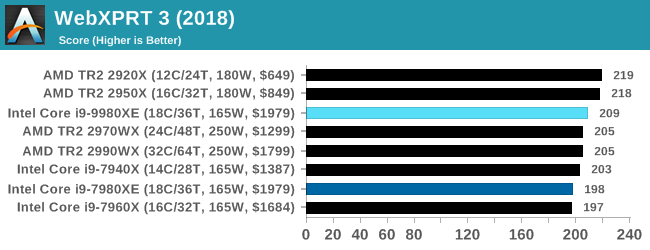
WebXPRT 2015: HTML5 and Javascript Web UX Testing
The older version of WebXPRT is the 2015 edition, which focuses on a slightly different set of web technologies and frameworks that are in use today. This is still a relevant test, especially for users interacting with not-the-latest web applications in the market, of which there are a lot. Web framework development is often very quick but with high turnover, meaning that frameworks are quickly developed, built-upon, used, and then developers move on to the next, and adjusting an application to a new framework is a difficult arduous task, especially with rapid development cycles. This leaves a lot of applications as ‘fixed-in-time’, and relevant to user experience for many years.
Similar to WebXPRT3, the main benchmark is a sectional run repeated seven times, with a final score. We repeat the whole thing four times, and average those final scores.
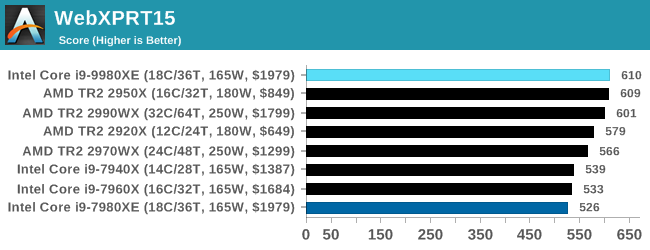
Speedometer 2: JavaScript Frameworks
Our newest web test is Speedometer 2, which is a accrued test over a series of javascript frameworks to do three simple things: built a list, enable each item in the list, and remove the list. All the frameworks implement the same visual cues, but obviously apply them from different coding angles.
Our test goes through the list of frameworks, and produces a final score indicative of ‘rpm’, one of the benchmarks internal metrics. We report this final score.
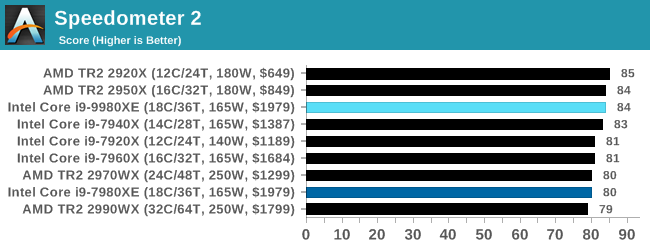
Google Octane 2.0: Core Web Compute
A popular web test for several years, but now no longer being updated, is Octane, developed by Google. Version 2.0 of the test performs the best part of two-dozen compute related tasks, such as regular expressions, cryptography, ray tracing, emulation, and Navier-Stokes physics calculations.
The test gives each sub-test a score and produces a geometric mean of the set as a final result. We run the full benchmark four times, and average the final results.
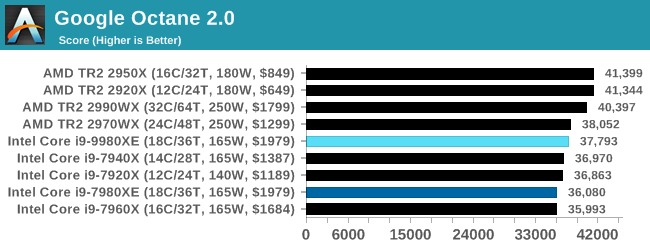
Mozilla Kraken 1.1: Core Web Compute
Even older than Octane is Kraken, this time developed by Mozilla. This is an older test that does similar computational mechanics, such as audio processing or image filtering. Kraken seems to produce a highly variable result depending on the browser version, as it is a test that is keenly optimized for.
The main benchmark runs through each of the sub-tests ten times and produces an average time to completion for each loop, given in milliseconds. We run the full benchmark four times and take an average of the time taken.
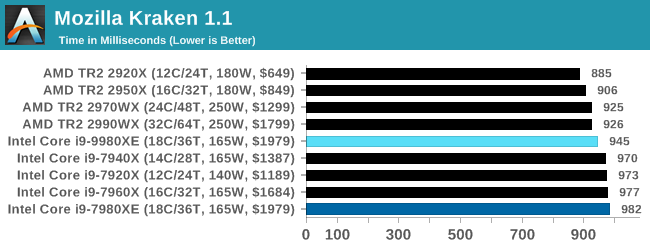
3DPM v1: Naïve Code Variant of 3DPM v2.1
The first legacy test in the suite is the first version of our 3DPM benchmark. This is the ultimate naïve version of the code, as if it was written by scientist with no knowledge of how computer hardware, compilers, or optimization works (which in fact, it was at the start). This represents a large body of scientific simulation out in the wild, where getting the answer is more important than it being fast (getting a result in 4 days is acceptable if it’s correct, rather than sending someone away for a year to learn to code and getting the result in 5 minutes).
In this version, the only real optimization was in the compiler flags (-O2, -fp:fast), compiling it in release mode, and enabling OpenMP in the main compute loops. The loops were not configured for function size, and one of the key slowdowns is false sharing in the cache. It also has long dependency chains based on the random number generation, which leads to relatively poor performance on specific compute microarchitectures.
3DPM v1 can be downloaded with our 3DPM v2 code here: 3DPMv2.1.rar (13.0 MB)
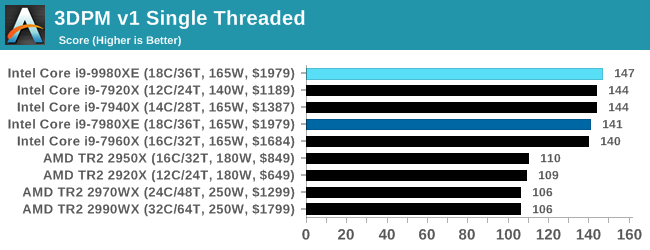
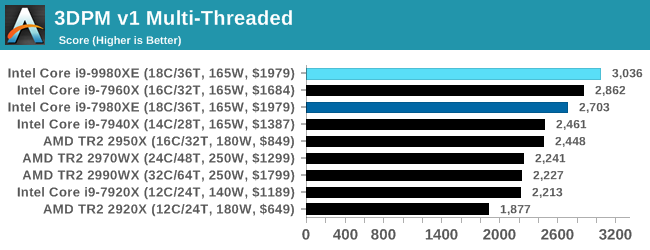
x264 HD 3.0: Older Transcode Test
This transcoding test is super old, and was used by Anand back in the day of Pentium 4 and Athlon II processors. Here a standardized 720p video is transcoded with a two-pass conversion, with the benchmark showing the frames-per-second of each pass. This benchmark is single-threaded, and between some micro-architectures we seem to actually hit an instructions-per-clock wall.
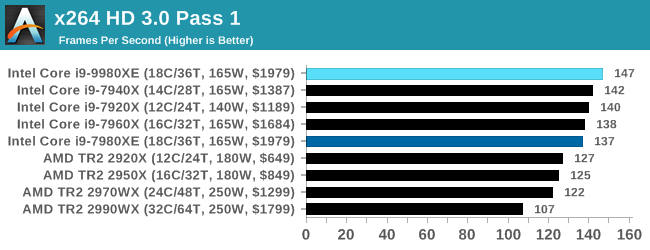
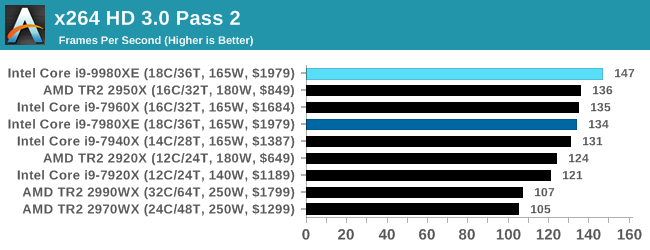
HEDT Performance: SYSMark 2018
You either love it or hate it. BAPCo’s SYSMark suite of tests is both an interesting combination of benchmarks but also clouded in a substantial amount of ire. The altruistic original goal was to develop an industry standard suite of real-world tests. AMD (and NVIDIA) left BAPCo several years ago citing that workloads were being chosen on purpose that favoured Intel processors, and didn’t include enough several emerging computing paradigms for the industry. Intel disagrees with that statement, and here we are today.
We run this disclaimer on our SYSMark testing primarily to emphasise that this benchmark suite, while some consider it more than relevant and encompassing a lot of modern professional software, others feel is engineered with specific goals in mind.
We haven’t run SYSMark on every processor, as it requires a fresh OS image compared to our automated suite, and requires refreshing that image every seven days. As a result we are trying to do sets of processors at a time where it makes sense and when time is available.
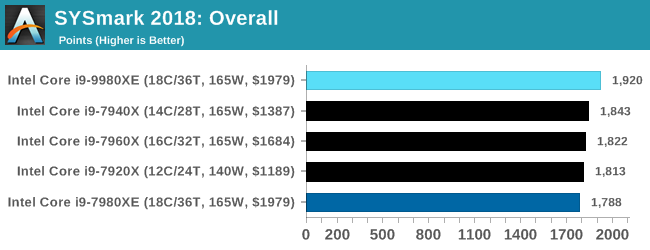
It’s clear from the Intel comparisons that the i9-9980XE takes a lead here, with a nice bump over the 7980XE of around 7% in the overall test. Given that the 7900X is the best of the Skylake-X processors, it will be interesting to see what the 9900X scores here.
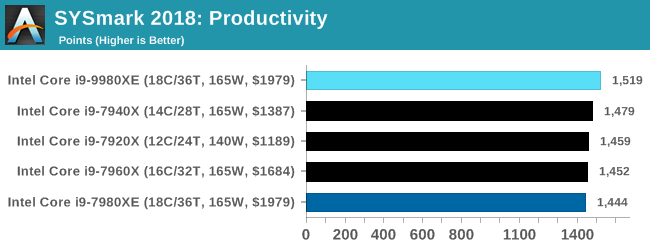
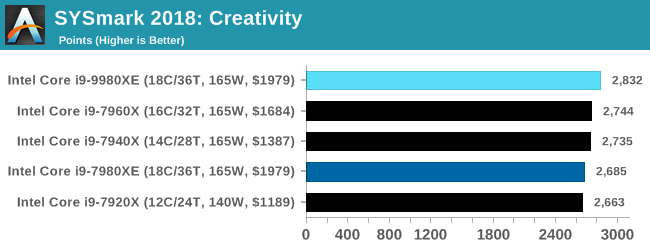
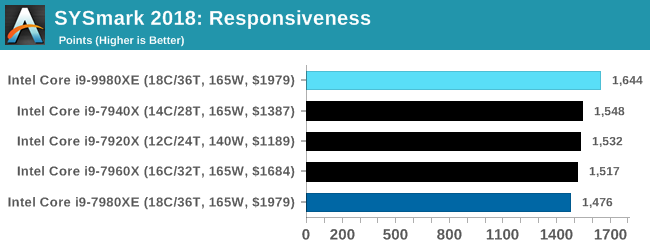
Gaming: World of Tanks enCore
Albeit different to most of the other commonly played MMO or massively multiplayer online games, World of Tanks is set in the mid-20th century and allows players to take control of a range of military based armored vehicles. World of Tanks (WoT) is developed and published by Wargaming who are based in Belarus, with the game’s soundtrack being primarily composed by Belarusian composer Sergey Khmelevsky. The game offers multiple entry points including a free-to-play element as well as allowing players to pay a fee to open up more features. One of the most interesting things about this tank based MMO is that it achieved eSports status when it debuted at the World Cyber Games back in 2012.
World of Tanks enCore is a demo application for a new and unreleased graphics engine penned by the Wargaming development team. Over time the new core engine will implemented into the full game upgrading the games visuals with key elements such as improved water, flora, shadows, lighting as well as other objects such as buildings. The World of Tanks enCore demo app not only offers up insight into the impending game engine changes, but allows users to check system performance to see if the new engine run optimally on their system.
| AnandTech CPU Gaming 2019 Game List | ||||||||
| Game | Genre | Release Date | API | IGP | Low | Med | High | |
| World of Tanks enCore | Driving / Action | Feb 2018 |
DX11 | 768p Minimum |
1080p Medium |
1080p Ultra |
4K Ultra |
|
All of our benchmark results can also be found in our benchmark engine, Bench.
| Game | IGP | Low | Medium | High |
| Average FPS | 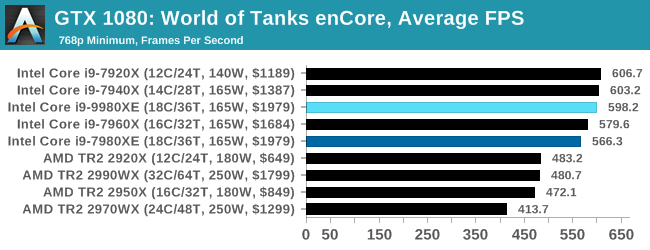 |
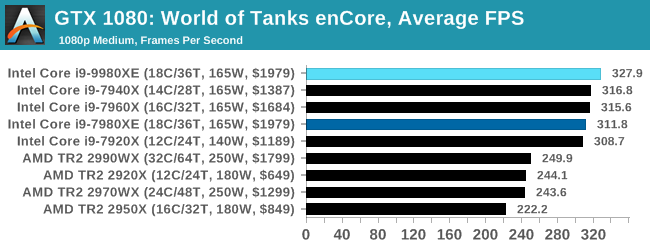 |
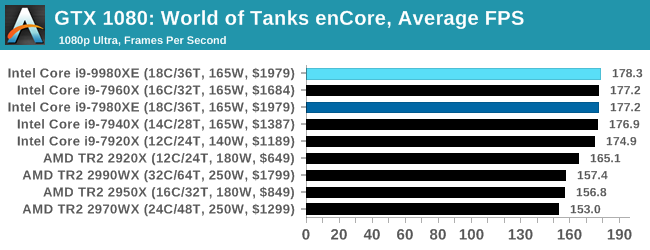 |
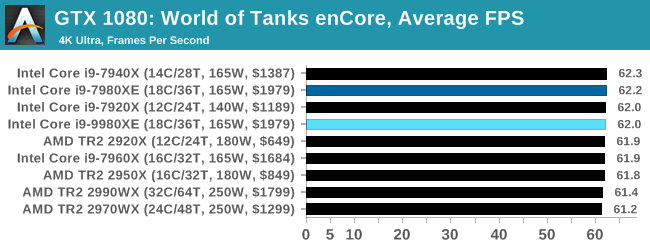 |
| 95th Percentile | 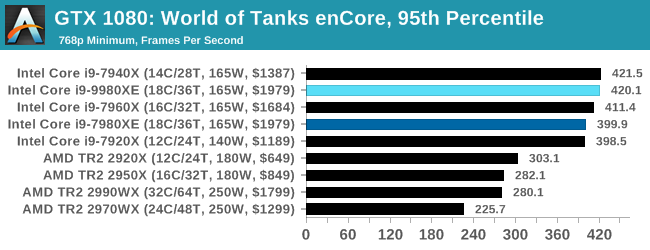 |
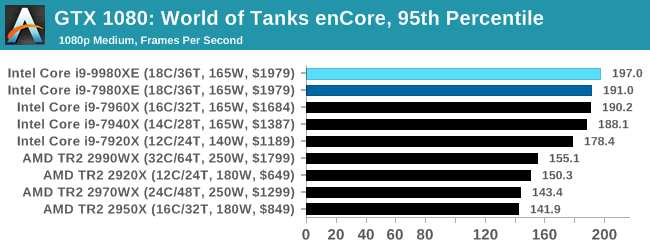 |
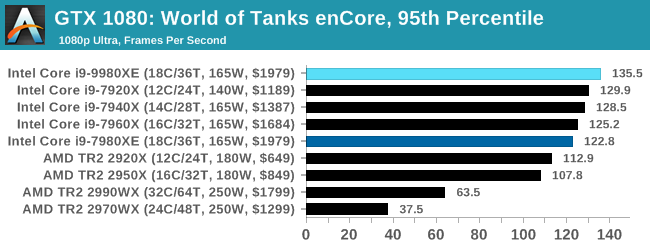 |
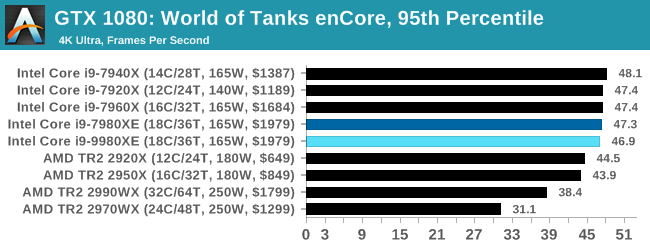 |
Gaming: Final Fantasy XV
Upon arriving to PC earlier this, Final Fantasy XV: Windows Edition was given a graphical overhaul as it was ported over from console, fruits of their successful partnership with NVIDIA, with hardly any hint of the troubles during Final Fantasy XV's original production and development.
In preparation for the launch, Square Enix opted to release a standalone benchmark that they have since updated. Using the Final Fantasy XV standalone benchmark gives us a lengthy standardized sequence to record, although it should be noted that its heavy use of NVIDIA technology means that the Maximum setting has problems - it renders items off screen. To get around this, we use the standard preset which does not have these issues.
Square Enix has patched the benchmark with custom graphics settings and bugfixes to be much more accurate in profiling in-game performance and graphical options. For our testing, we run the standard benchmark with a FRAPs overlay, taking a 6 minute recording of the test.
| AnandTech CPU Gaming 2019 Game List | ||||||||
| Game | Genre | Release Date | API | IGP | Low | Med | High | |
| Final Fantasy XV | JRPG | Mar 2018 |
DX11 | 720p Standard |
1080p Standard |
4K Standard |
8K Standard |
|
All of our benchmark results can also be found in our benchmark engine, Bench.
| Game | IGP | Low | Medium | High |
| Average FPS | 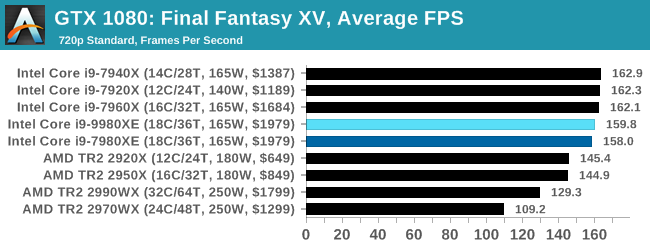 |
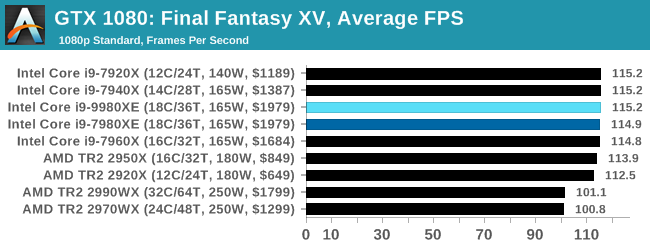 |
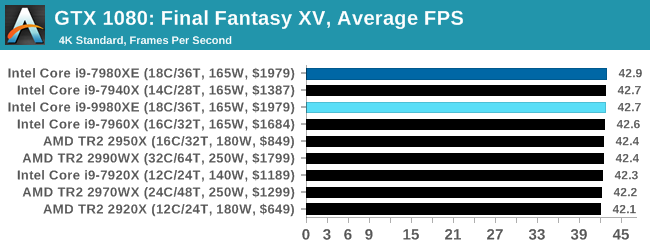 |
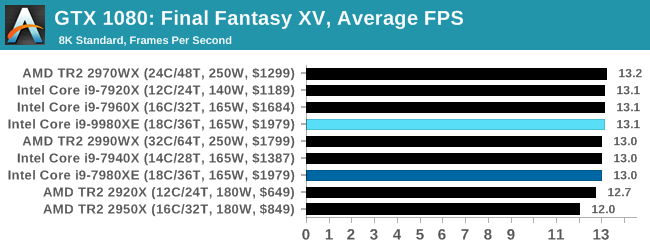 |
| 95th Percentile | 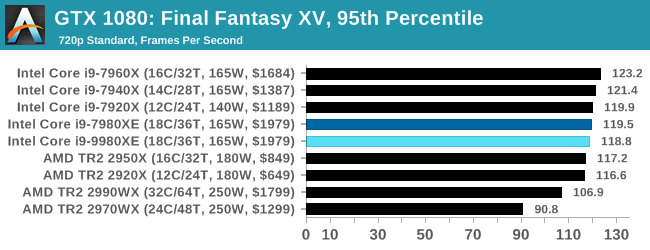 |
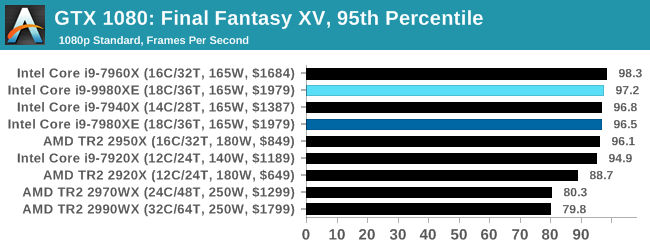 |
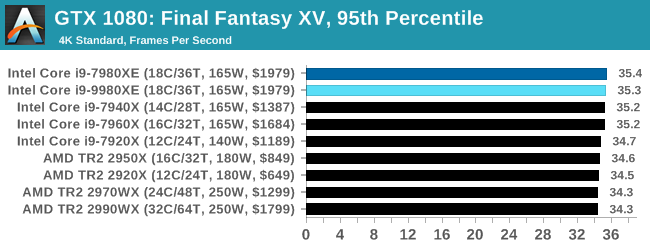 |
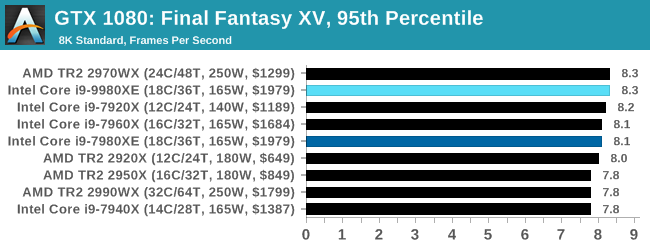 |
Gaming: Shadow of War
Next up is Middle-earth: Shadow of War, the sequel to Shadow of Mordor. Developed by Monolith, whose last hit was arguably F.E.A.R., Shadow of Mordor returned them to the spotlight with an innovative NPC rival generation and interaction system called the Nemesis System, along with a storyline based on J.R.R. Tolkien's legendarium, and making it work on a highly modified engine that originally powered F.E.A.R. in 2005.
Using the new LithTech Firebird engine, Shadow of War improves on the detail and complexity, and with free add-on high-resolution texture packs, offers itself as a good example of getting the most graphics out of an engine that may not be bleeding edge. Shadow of War also supports HDR (HDR10).
| AnandTech CPU Gaming 2019 Game List | ||||||||
| Game | Genre | Release Date | API | IGP | Low | Med | High | |
| Shadow of War | Action / RPG | Sep 2017 |
DX11 | 720p Ultra |
1080p Ultra |
4K High |
8K High |
|
All of our benchmark results can also be found in our benchmark engine, Bench.
| Game | IGP | Low | Medium | High |
| Average FPS | 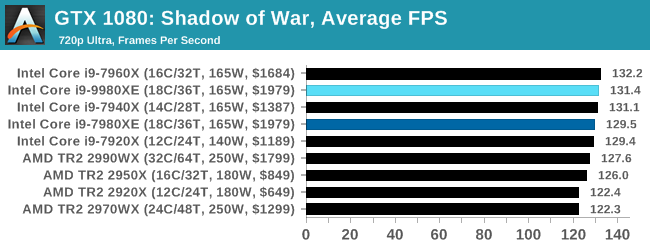 |
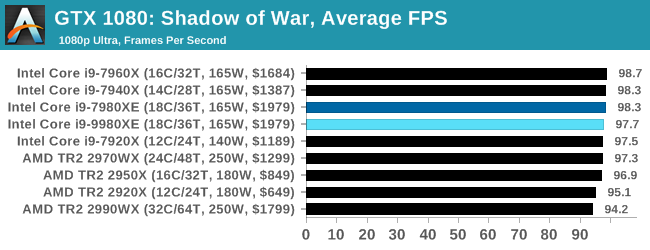 |
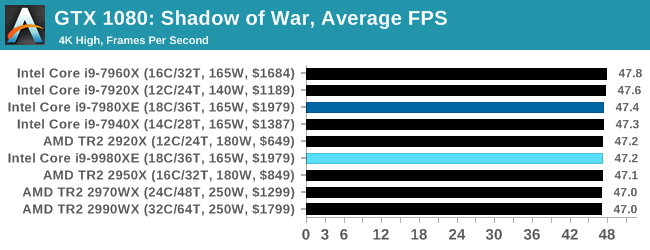 |
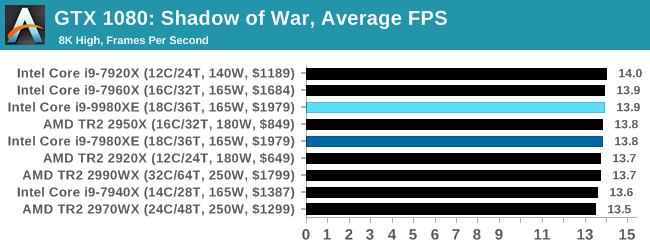 |
Gaming: Civilization 6 (DX12)
Originally penned by Sid Meier and his team, the Civ series of turn-based strategy games are a cult classic, and many an excuse for an all-nighter trying to get Gandhi to declare war on you due to an integer overflow. Truth be told I never actually played the first version, but every edition from the second to the sixth, including the fourth as voiced by the late Leonard Nimoy, it a game that is easy to pick up, but hard to master.
Benchmarking Civilization has always been somewhat of an oxymoron – for a turn based strategy game, the frame rate is not necessarily the important thing here and even in the right mood, something as low as 5 frames per second can be enough. With Civilization 6 however, Firaxis went hardcore on visual fidelity, trying to pull you into the game. As a result, Civilization can taxing on graphics and CPUs as we crank up the details, especially in DirectX 12.
Perhaps a more poignant benchmark would be during the late game, when in the older versions of Civilization it could take 20 minutes to cycle around the AI players before the human regained control. The new version of Civilization has an integrated ‘AI Benchmark’, although it is not currently part of our benchmark portfolio yet, due to technical reasons which we are trying to solve. Instead, we run the graphics test, which provides an example of a mid-game setup at our settings.
| AnandTech CPU Gaming 2019 Game List | ||||||||
| Game | Genre | Release Date | API | IGP | Low | Med | High | |
| Civilization VI | RTS | Oct 2016 |
DX12 | 1080p Ultra |
4K Ultra |
8K Ultra |
16K Low |
|
All of our benchmark results can also be found in our benchmark engine, Bench.
| Game | IGP | Low | Medium | High |
| Average FPS | 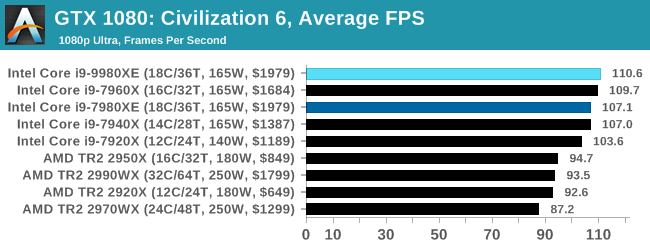 |
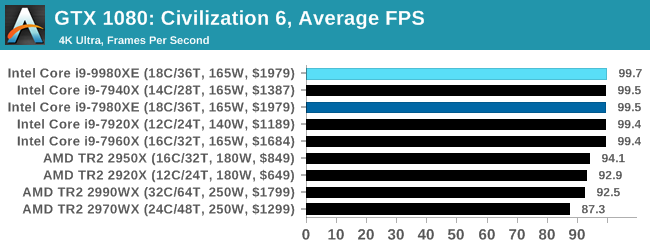 |
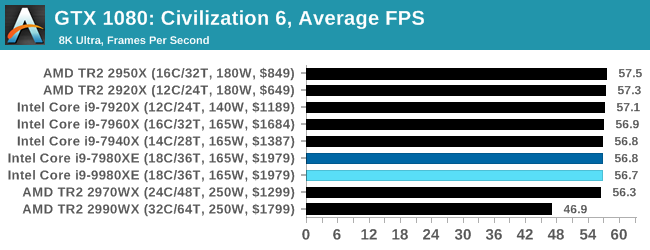 |
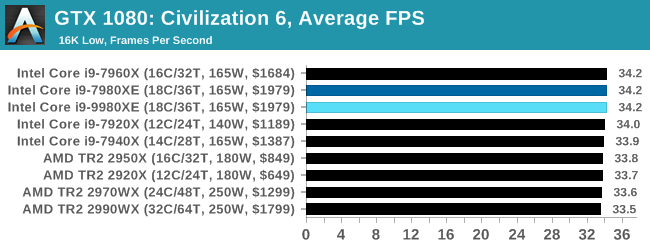 |
| 95th Percentile | 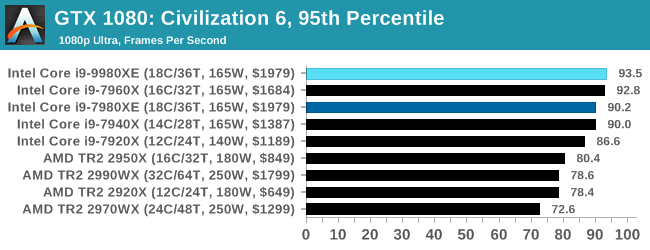 |
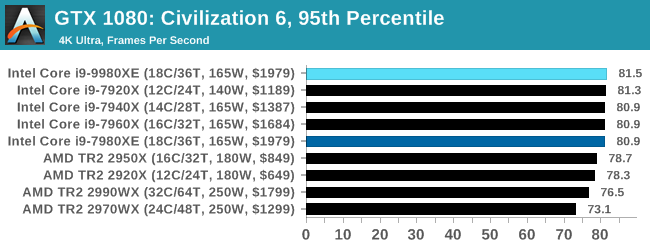 |
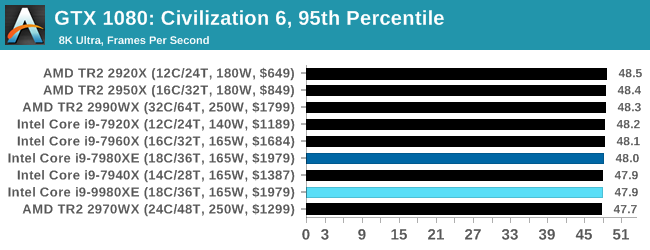 |
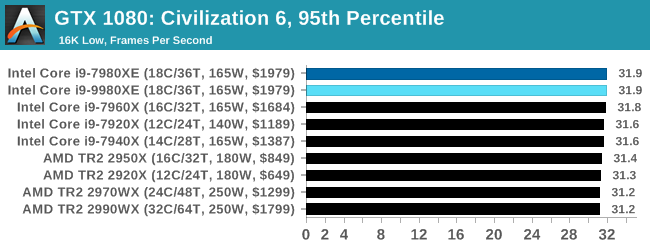 |
Gaming: Ashes Classic (DX12)
Seen as the holy child of DirectX12, Ashes of the Singularity (AoTS, or just Ashes) has been the first title to actively go explore as many of the DirectX12 features as it possibly can. Stardock, the developer behind the Nitrous engine which powers the game, has ensured that the real-time strategy title takes advantage of multiple cores and multiple graphics cards, in as many configurations as possible.
As a real-time strategy title, Ashes is all about responsiveness during both wide open shots but also concentrated battles. With DirectX12 at the helm, the ability to implement more draw calls per second allows the engine to work with substantial unit depth and effects that other RTS titles had to rely on combined draw calls to achieve, making some combined unit structures ultimately very rigid.
Stardock clearly understand the importance of an in-game benchmark, ensuring that such a tool was available and capable from day one, especially with all the additional DX12 features used and being able to characterize how they affected the title for the developer was important. The in-game benchmark performs a four minute fixed seed battle environment with a variety of shots, and outputs a vast amount of data to analyze.
For our benchmark, we run Ashes Classic: an older version of the game before the Escalation update. The reason for this is that this is easier to automate, without a splash screen, but still has a strong visual fidelity to test.
| AnandTech CPU Gaming 2019 Game List | ||||||||
| Game | Genre | Release Date | API | IGP | Low | Med | High | |
| Ashes: Classic | RTS | Mar 2016 |
DX12 | 720p Standard |
1080p Standard |
1440p Standard |
4K Standard |
|
Ashes has dropdown options for MSAA, Light Quality, Object Quality, Shading Samples, Shadow Quality, Textures, and separate options for the terrain. There are several presents, from Very Low to Extreme: we run our benchmarks at the above settings, and take the frame-time output for our average and percentile numbers.
All of our benchmark results can also be found in our benchmark engine, Bench.
| Game | IGP | Low | Medium | High |
| Average FPS | 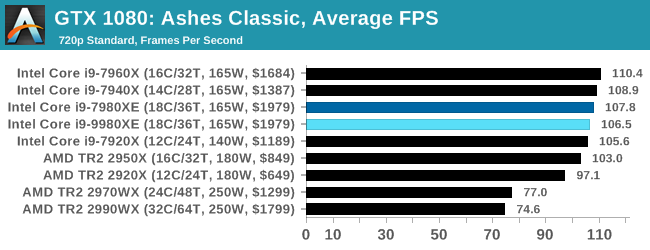 |
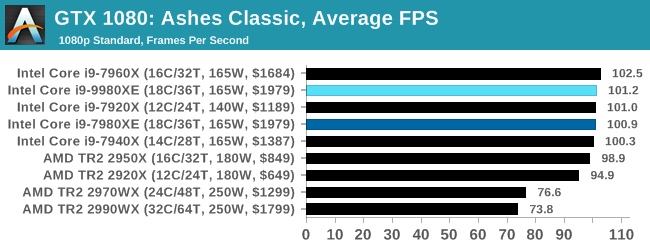 |
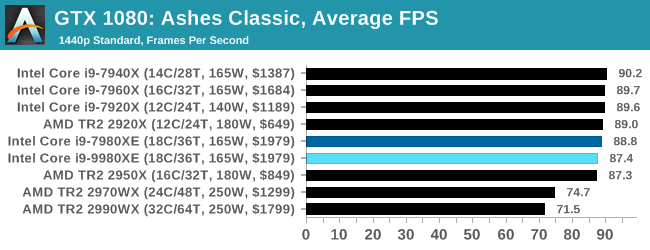 |
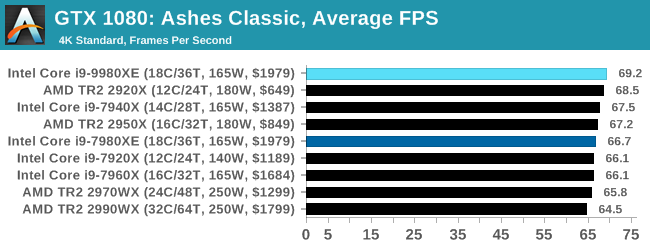 |
| 95th Percentile | 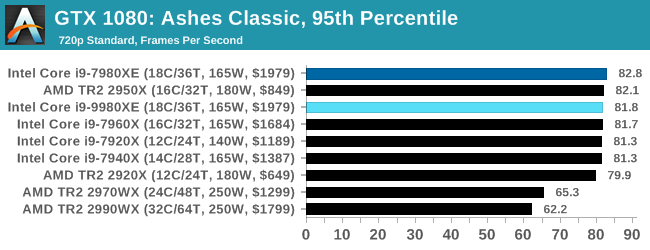 |
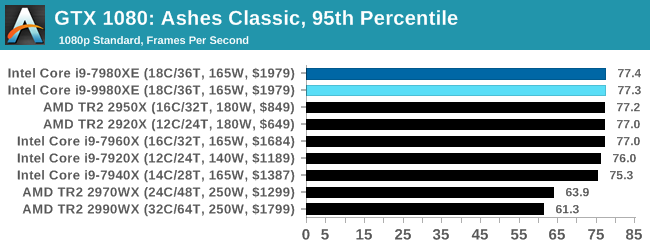 |
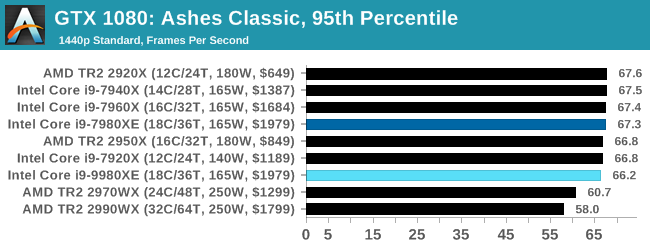 |
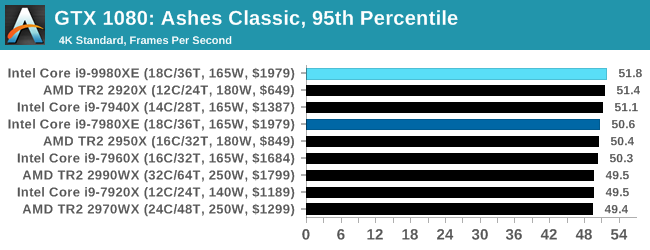 |
Gaming: Strange Brigade (DX12, Vulkan)
Strange Brigade is based in 1903’s Egypt and follows a story which is very similar to that of the Mummy film franchise. This particular third-person shooter is developed by Rebellion Developments which is more widely known for games such as the Sniper Elite and Alien vs Predator series. The game follows the hunt for Seteki the Witch Queen who has arose once again and the only ‘troop’ who can ultimately stop her. Gameplay is cooperative centric with a wide variety of different levels and many puzzles which need solving by the British colonial Secret Service agents sent to put an end to her reign of barbaric and brutality.
The game supports both the DirectX 12 and Vulkan APIs and houses its own built-in benchmark which offers various options up for customization including textures, anti-aliasing, reflections, draw distance and even allows users to enable or disable motion blur, ambient occlusion and tessellation among others. AMD has boasted previously that Strange Brigade is part of its Vulkan API implementation offering scalability for AMD multi-graphics card configurations.
| AnandTech CPU Gaming 2019 Game List | ||||||||
| Game | Genre | Release Date | API | IGP | Low | Med | High | |
| Strange Brigade* | FPS | Aug 2018 |
DX12 Vulkan |
720p Low |
1080p Medium |
1440p High |
4K Ultra |
|
| *Strange Brigade is run in DX12 and Vulkan modes | ||||||||
All of our benchmark results can also be found in our benchmark engine, Bench.
| Game | IGP | Low | Medium | High |
| Average FPS | 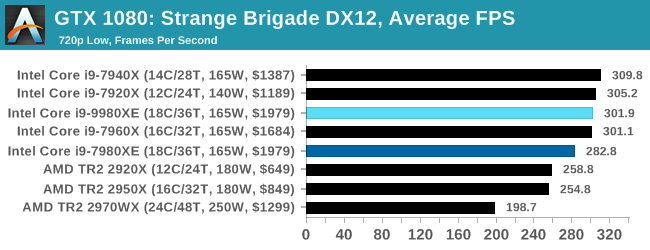 |
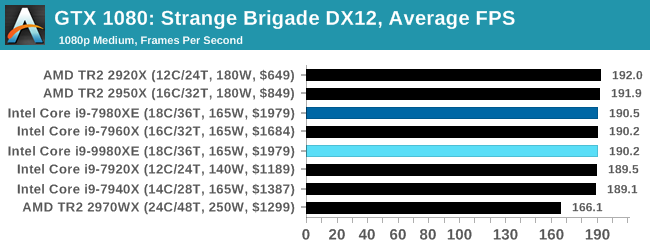 |
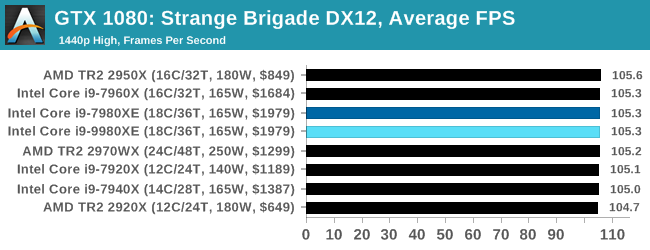 |
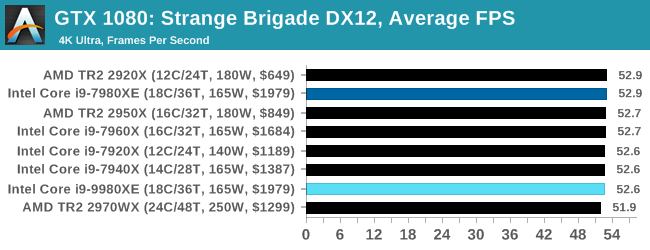 |
| 95th Percentile | 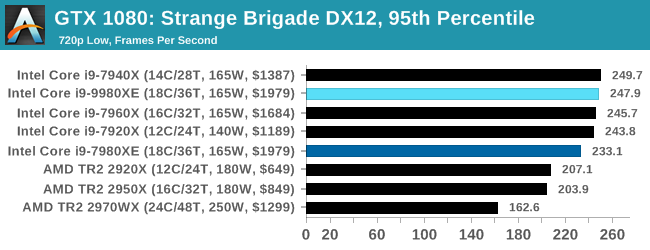 |
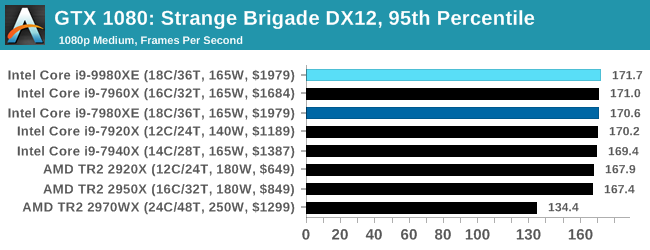 |
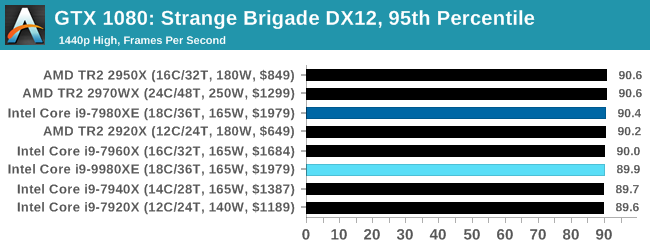 |
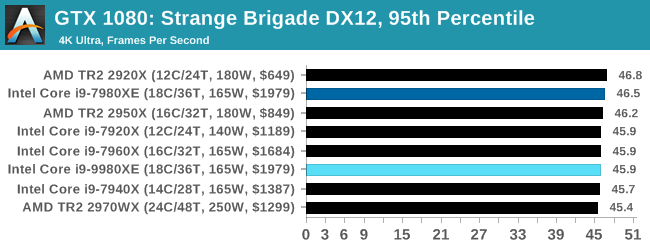 |
| Game | IGP | Low | Medium | High |
| Average FPS | 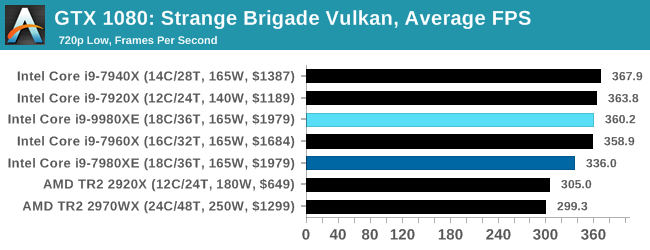 |
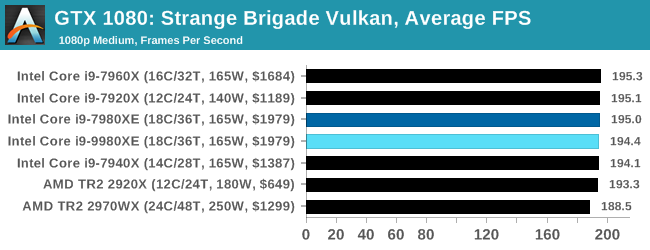 |
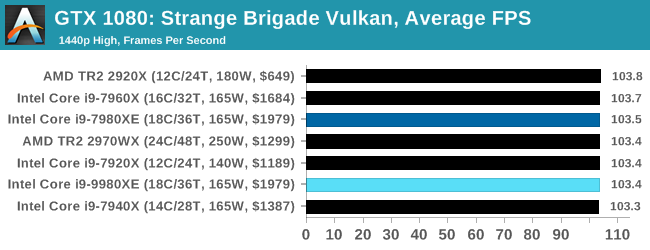 |
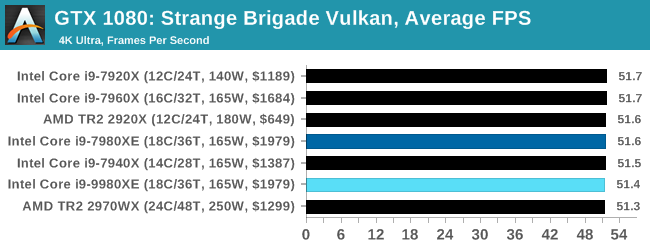 |
| 95th Percentile | 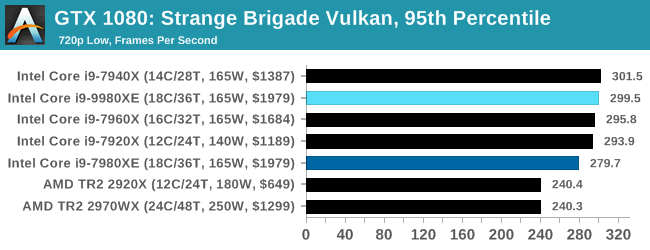 |
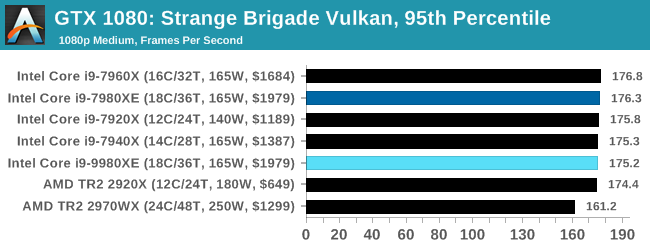 |
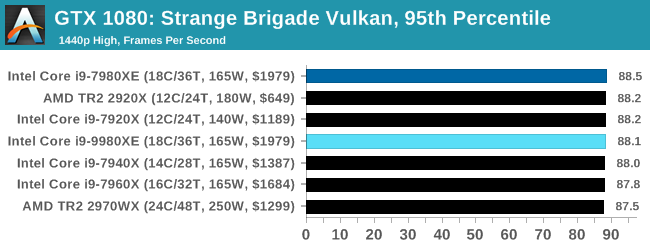 |
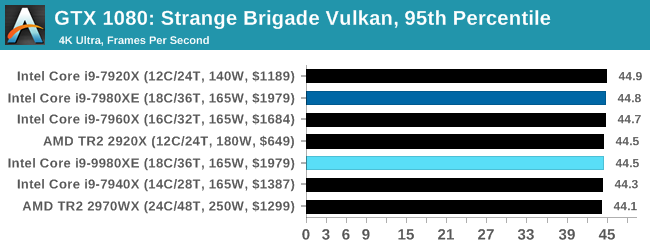 |
Gaming: Grand Theft Auto V
The highly anticipated iteration of the Grand Theft Auto franchise hit the shelves on April 14th 2015, with both AMD and NVIDIA in tow to help optimize the title. GTA doesn’t provide graphical presets, but opens up the options to users and extends the boundaries by pushing even the hardest systems to the limit using Rockstar’s Advanced Game Engine under DirectX 11. Whether the user is flying high in the mountains with long draw distances or dealing with assorted trash in the city, when cranked up to maximum it creates stunning visuals but hard work for both the CPU and the GPU.
For our test we have scripted a version of the in-game benchmark. The in-game benchmark consists of five scenarios: four short panning shots with varying lighting and weather effects, and a fifth action sequence that lasts around 90 seconds. We use only the final part of the benchmark, which combines a flight scene in a jet followed by an inner city drive-by through several intersections followed by ramming a tanker that explodes, causing other cars to explode as well. This is a mix of distance rendering followed by a detailed near-rendering action sequence, and the title thankfully spits out frame time data.
There are no presets for the graphics options on GTA, allowing the user to adjust options such as population density and distance scaling on sliders, but others such as texture/shadow/shader/water quality from Low to Very High. Other options include MSAA, soft shadows, post effects, shadow resolution and extended draw distance options. There is a handy option at the top which shows how much video memory the options are expected to consume, with obvious repercussions if a user requests more video memory than is present on the card (although there’s no obvious indication if you have a low end GPU with lots of GPU memory, like an R7 240 4GB).
| AnandTech CPU Gaming 2019 Game List | ||||||||
| Game | Genre | Release Date | API | IGP | Low | Med | High | |
| Grand Theft Auto V | Open World | Apr 2015 |
DX11 | 720p Low |
1080p High |
1440p Very High |
4K Ultra |
|
All of our benchmark results can also be found in our benchmark engine, Bench.
| Game | IGP | Low | Medium | High |
| Average FPS | 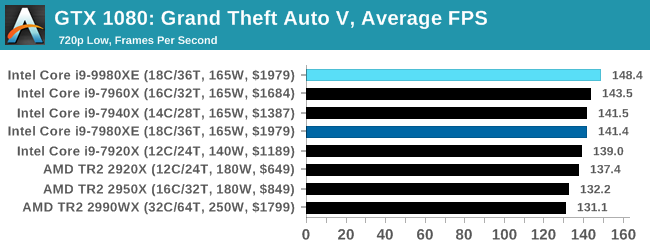 |
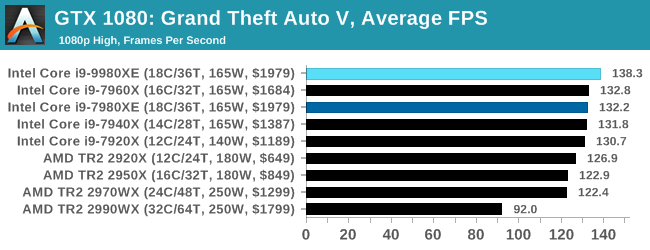 |
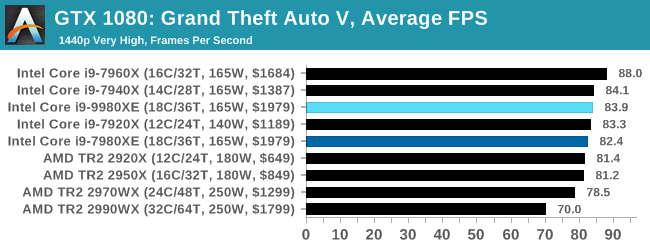 |
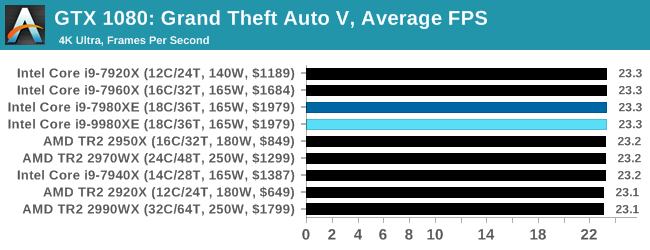 |
| 95th Percentile | 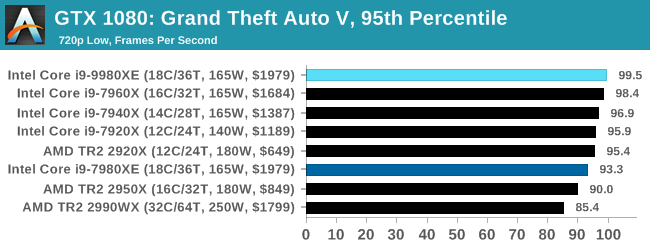 |
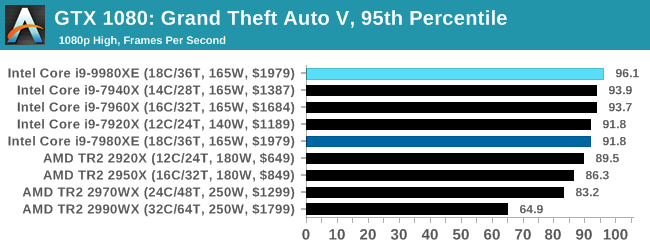 |
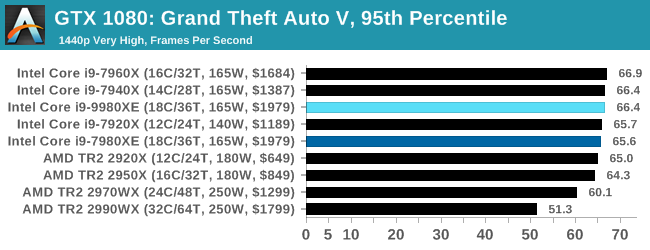 |
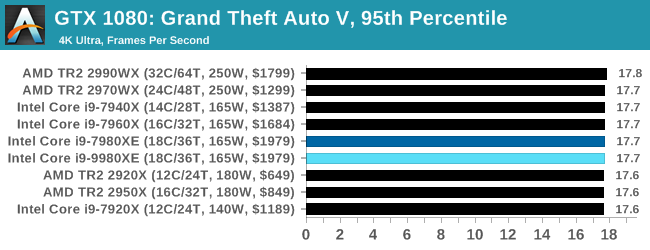 |
Gaming: Far Cry 5
The latest title in Ubisoft's Far Cry series lands us right into the unwelcoming arms of an armed militant cult in Montana, one of the many middles-of-nowhere in the United States. With a charismatic and enigmatic adversary, gorgeous landscapes of the northwestern American flavor, and lots of violence, it is classic Far Cry fare. Graphically intensive in an open-world environment, the game mixes in action and exploration.
Far Cry 5 does support Vega-centric features with Rapid Packed Math and Shader Intrinsics. Far Cry 5 also supports HDR (HDR10, scRGB, and FreeSync 2). We use the in-game benchmark for our data, and report the average/minimum frame rates.
| AnandTech CPU Gaming 2019 Game List | ||||||||
| Game | Genre | Release Date | API | IGP | Low | Med | High | |
| Far Cry 5 | FPS | Mar 2018 |
DX11 | 720p Low |
1080p Normal |
1440p High |
4K Ultra |
|
All of our benchmark results can also be found in our benchmark engine, Bench.
| Game | IGP | Low | Medium | High |
| Average FPS | 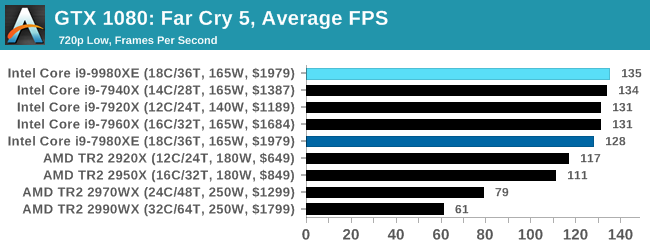 |
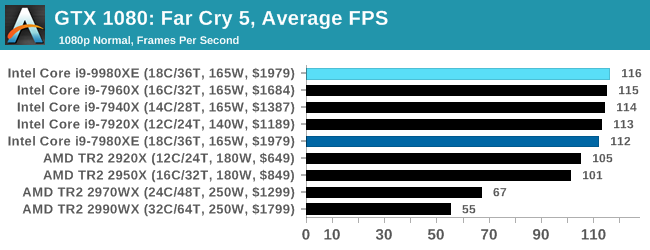 |
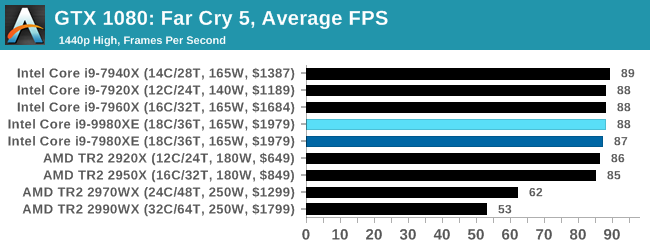 |
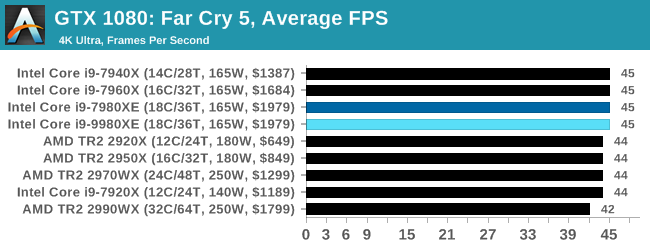 |
| 95th Percentile | 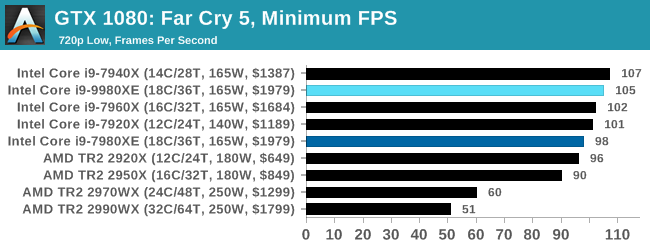 |
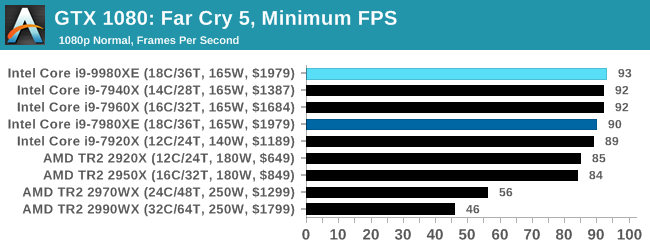 |
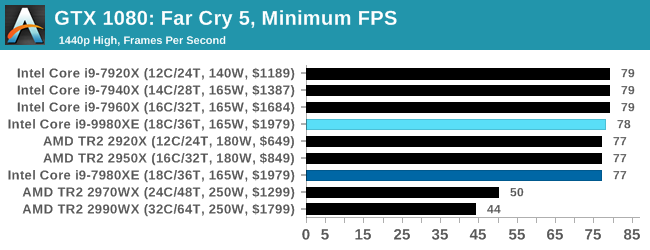 |
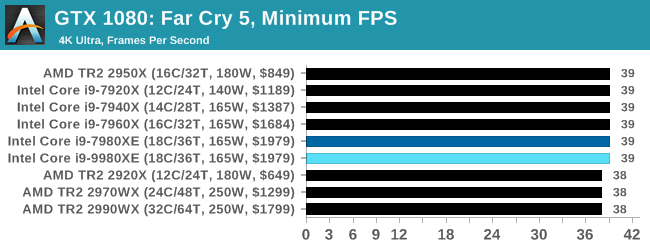 |
Gaming: Shadow of the Tomb Raider (DX12)
The latest instalment of the Tomb Raider franchise does less rising and lurks more in the shadows with Shadow of the Tomb Raider. As expected this action-adventure follows Lara Croft which is the main protagonist of the franchise as she muscles through the Mesoamerican and South American regions looking to stop a Mayan apocalyptic she herself unleashed. Shadow of the Tomb Raider is the direct sequel to the previous Rise of the Tomb Raider and was developed by Eidos Montreal and Crystal Dynamics and was published by Square Enix which hit shelves across multiple platforms in September 2018. This title effectively closes the Lara Croft Origins story and has received critical acclaims upon its release.
The integrated Shadow of the Tomb Raider benchmark is similar to that of the previous game Rise of the Tomb Raider, which we have used in our previous benchmarking suite. The newer Shadow of the Tomb Raider uses DirectX 11 and 12, with this particular title being touted as having one of the best implementations of DirectX 12 of any game released so far.
| AnandTech CPU Gaming 2019 Game List | ||||||||
| Game | Genre | Release Date | API | IGP | Low | Med | High | |
| Shadow of the Tomb Raider | Action | Sep 2018 |
DX12 | 720p Low |
1080p Medium |
1440p High |
4K Highest |
|
All of our benchmark results can also be found in our benchmark engine, Bench.
| Game | IGP | Low | Medium | High |
| Average FPS | 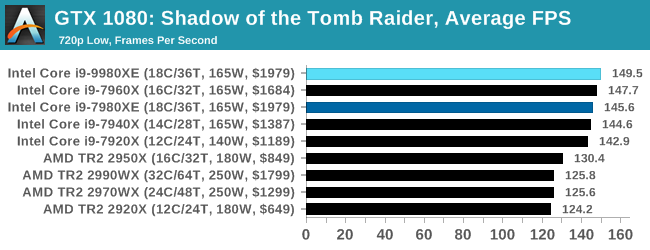 |
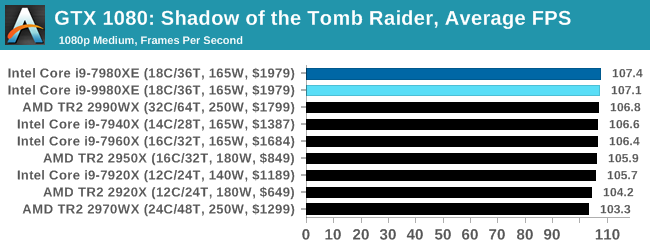 |
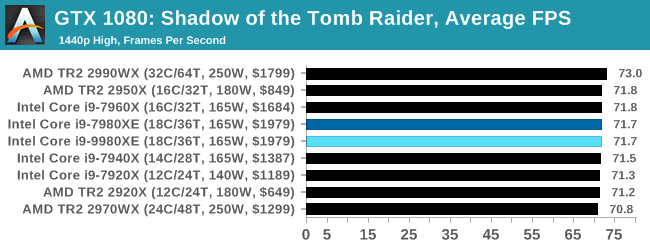 |
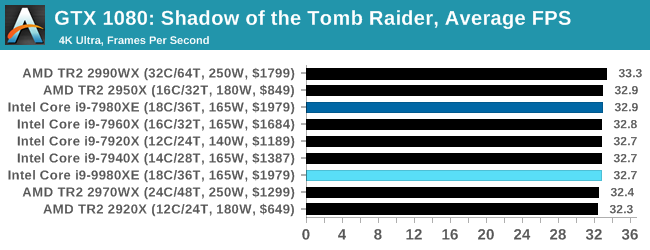 |
| 95th Percentile | 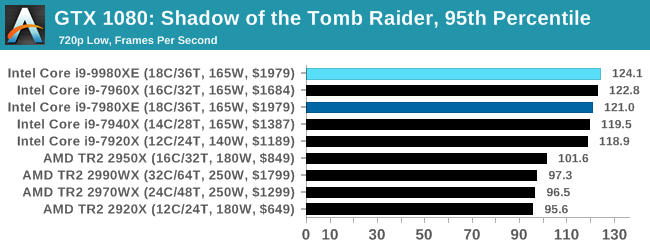 |
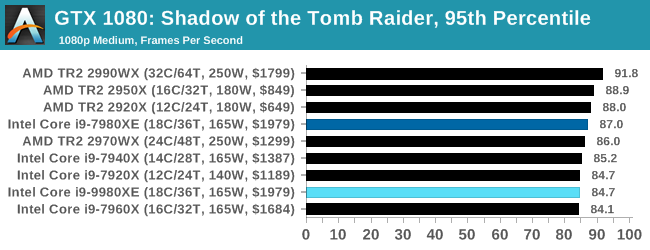 |
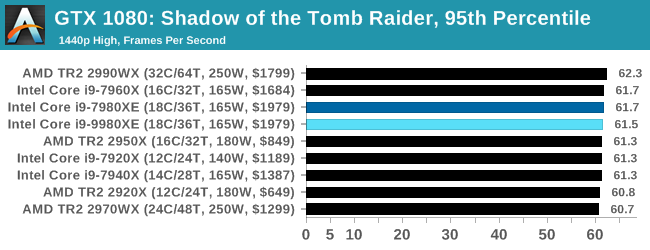 |
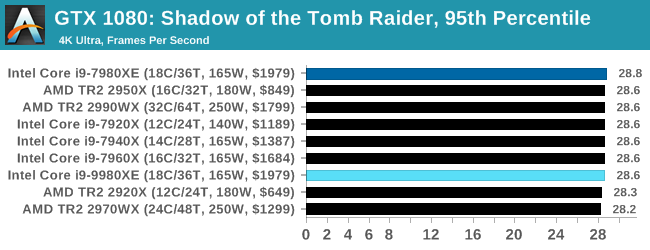 |
Gaming: F1 2018
Aside from keeping up-to-date on the Formula One world, F1 2017 added HDR support, which F1 2018 has maintained; otherwise, we should see any newer versions of Codemasters' EGO engine find its way into F1. Graphically demanding in its own right, F1 2018 keeps a useful racing-type graphics workload in our benchmarks.
We use the in-game benchmark, set to run on the Montreal track in the wet, driving as Lewis Hamilton from last place on the grid. Data is taken over a one-lap race.
| AnandTech CPU Gaming 2019 Game List | ||||||||
| Game | Genre | Release Date | API | IGP | Low | Med | High | |
| F1 2018 | Racing | Aug 2018 |
DX11 | 720p Low |
1080p Med |
4K High |
4K Ultra |
|
All of our benchmark results can also be found in our benchmark engine, Bench.
| Game | IGP | Low | Medium | High |
| Average FPS | 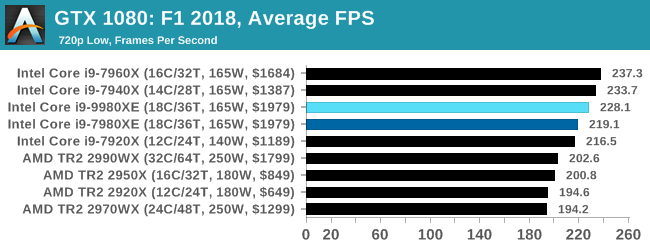 |
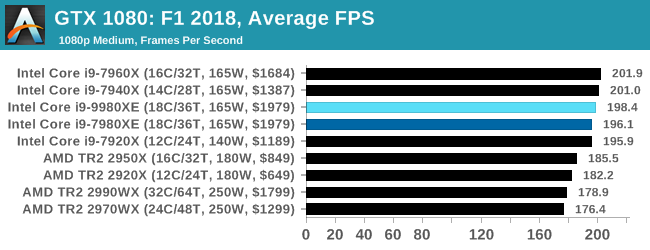 |
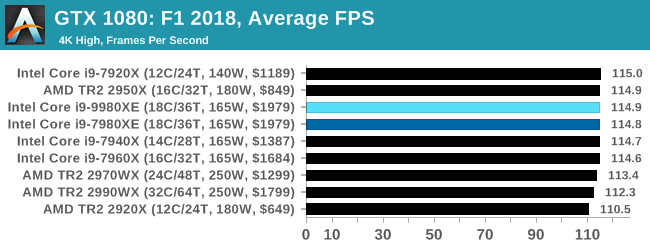 |
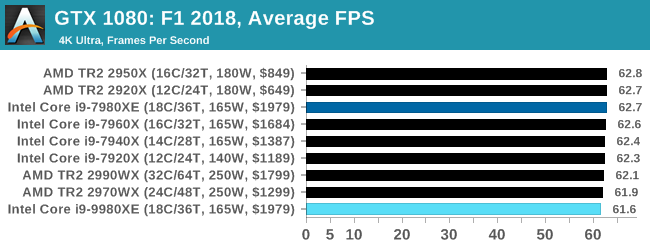 |
| 95th Percentile | 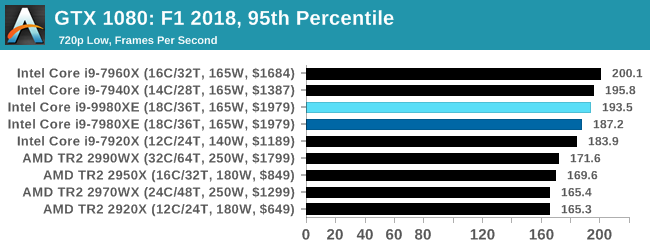 |
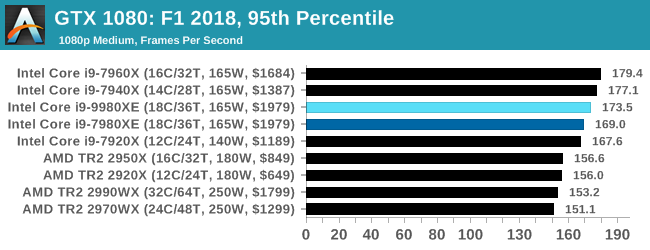 |
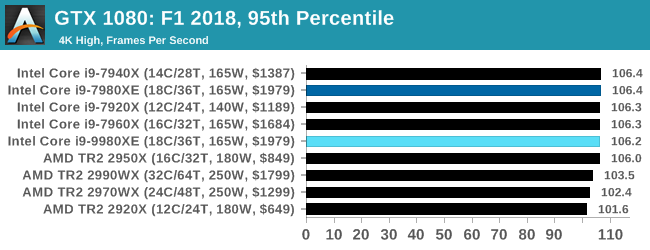 |
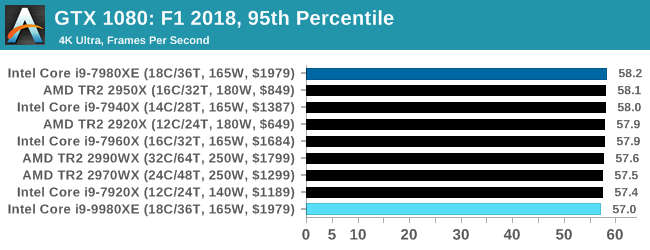 |
Power Consumption
One of the key topics in power consumption recently has been whether Intel’s approach to power, or to how it represents its Thermal Design Power (TDP) values, is valid or not. Intel’s take on TDP is that it should represent the sustained power of the processor, which unfortunately does not take into account any of the turbo modes available to the users (or disclose how long those turbo modes should be available for). Part of this is not only confusing, but motherboard manufacturers rarely use Intel specifications for these limits anyway, as you can read in our article covering the practice here.
With the Core i9-9980XE, the typical representation of power is used: stick to the turbo tables unless the system is thermally compromised. In this case the 165W TDP value is a guide, not a limit or a suggestion – it relies on the quality of the silicon and the ability of the motherboard manufacturer to be stable, performance focused, and competitive.
Comparing the Core i9-9980XE to the Core i9-7980XE, the new processor has a higher base frequency by 400 MHz, a higher single core turbo frequency by 100 MHz, and a higher all-core turbo, but uses a newer 14++ manufacturing process and soldered thermal interface material. The peak power consumption numbers are as follows:
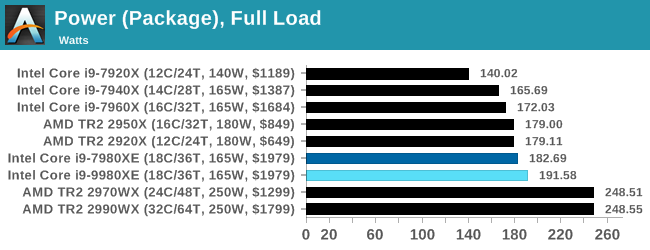
Looking at the full chip values, the peak power consumption we observed for the Core i9-9980XE is 192W. This is 9-10W higher than our Core i9-7980XE sample.
If we remove the ‘idle’ power numbers away to see the core-only power, then the Core i9-9980XE uses around 152W just for the cores, which should be around 8.5W per core. The 32-core Threadripper 2990WX by contrast uses around 6W per core.
If we look at the efficiency of each processor, with our power numbers taken during a POV-Ray run:
The Core i9-7980XE gets a performance per watt of 43.3 POV-Ray points per watt - the new Core i9-9980XE scores a little less at 42.7, as for the extra 5% of power, we get a 3.6% increase in performance. For competition, the only HEDT processors coming close are the other Intel HEDT parts, or the 2990WX at the top right of the diagram. Obviously, this is benchmark specific, but an interesting comparison nonetheless.
Core i9-9980XE Conclusion: A Generational Upgrade
Users (and investors) always want to see a year-on-year increase in performance in the products being offered. For those on the leading edge, where every little counts, dropping $2k on a new processor is nothing if it can be used to its fullest. For those on a longer upgrade cycle, a constant 10% annual improvement means that over 3 years they can expect a 33% increase in performance. As of late, there are several ways to increase performance: increase core count, increase frequency/power, increase efficiency, or increase IPC. That list is rated from easy to difficult: adding cores is usually trivial (until memory access becomes a bottleneck), while increasing efficiency and instructions per clock (IPC) is difficult but the best generational upgrade for everyone concerned.
For Intel’s latest Core i9-9980XE, its flagship high-end desktop processor, we have a mix of improved frequency and improved efficiency. Using an updated process has helped increase the core clocks compared to the previous generation, a 15% increase in the base clock, but we are also using around 5-6% more power at full load. In real-world terms, the Core i9-9980XE seems to give anywhere from a 0-10% performance increase in our benchmarks.
However, if we follow Intel’s previous cadence, this processor launch should have seen a substantial change in design. Normally Intel follows a new microarchitecture and socket with a process node update on the same socket with similar features but much improved efficiency. We didn’t get that. We got a refresh.
An Iteration When Intel Needs Evolution
When Intel announced that its latest set of high-end desktop processors was little more than a refresh, there was a subtle but mostly inaudible groan from the tech press at the event. We don’t particularly like generations using higher clocked refreshes with our graphics, so we certainly are not going to enjoy it with our processors. These new parts are yet another product line based on Intel’s 14nm Skylake family, and we’re wondering where Intel’s innovation has gone.
These new parts involve using larger silicon across the board, which enables more cache and PCIe lanes at the low end, and the updates to the manufacturing process afford some extra frequency. The new parts use soldered thermal interface material, which is what Intel used to use, and what enthusiasts have been continually requesting. None of this is innovation on the scale that Intel’s customer base is used to.
It all boils down to ‘more of the same, but slightly better’.
While Intel is having another crack at Skylake, its competition is trying to innovate, not only by trying new designs that may or may not work, but they are already showcasing the next generation several months in advance with both process node and microarchitectural changes. As much as Intel prides itself on its technological prowess, and has done well this decade, there’s something stuck in the pipe. At a time when Intel needs evolution, it is stuck doing refresh iterations.
Does It Matter?
The latest line out of Intel is that demand for its latest generation enterprise processors is booming. They physically cannot make enough, and other product lines (publicly, the lower power ones) are having to suffer when Intel can use those wafers to sell higher margin parts. The situation is dire enough that Intel is moving fab space to create more 14nm products in a hope to match demand should it continue. Intel has explicitly stated that while demand is high, it wants to focus on its high performance Xeon and Core product lines.
You can read our news item on Intel's investment announcement here.
While demand is high, the desire to innovate hits this odd miasma of ‘should we focus on squeezing every cent out of this high demand’ compared to ‘preparing for tomorrow’. With all the demand on the enterprise side, it means that the rapid update cycles required from the consumer side might not be to their liking – while consumers who buy one chip want 10-15% performance gains every year, the enterprise customers who need chips in high volumes are just happy to be able to purchase them. There’s no need for Intel to dip its toes into a new process node or design that offers +15% performance but reduces yield by more, and takes up the fab space.
Intel Promised Me
In one meeting with Intel’s engineers a couple of years back, just after the launch of Skylake, I was told that two years of 10% IPC growth is not an issue. These individuals know the details of Intel’s new platform designs, and I have no reason to doubt them. Back then, it was clear that Intel had the next one or two generations of Core microarchitecture updates mapped out, however the delays to 10nm seem to put a pin into those +10% IPC designs. Combine Intel’s 10nm woes with the demand on 14nm Skylake-SP parts, and it makes for one confusing mess. Intel is making plenty of money, and they seem to have designs in their back pocket ready to go, but while it is making super high margins, I worry we won’t see them. All the while, Intel’s competitors are trying to do something new to break the incumbents hold on the market.
Back to the Core i9-9980XE
Discussions on Intel’s roadmap and demand aside, our analysis of the Core i9-9980XE shows that it provides a reasonable uplift over the Core i9-7980XE for around the same price, albeit for a few more watts in power. For users looking at peak Intel multi-core performance on a consumer platform, it’s a reasonable generation-on-generation uplift, and it makes sense for those on a longer update cycle.
A side note on gaming – for users looking to push those high-frame rate monitors, the i9-9980XE gave a 2-4% uplift over our games at our 720p settings. Individual results varied from a 0-1% gain, such as in Ashes or Final Fantasy, up to a 5-7% gain in World of Tanks, Far Cry 5, and Strange Brigade. Beyond 1080p, we didn’t see much change.
When comparing against the AMD competition, it all depends on the workload. Intel has the better processor in most aspects of general workflow, such as lightly threaded workloads on the web, memory limited tests, compression, video transcoding, or AVX512 accelerated code, but AMD wins on dedicated processing, such as rendering with Blender, Corona, POV-Ray, and Cinema4D. Compiling is an interesting one, because in for both Intel and AMD, the more mid-range core count parts with higher turbo frequencies seem to do better.

